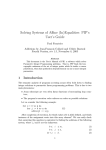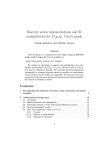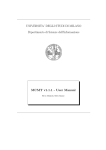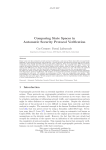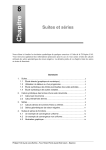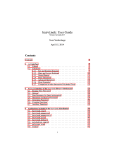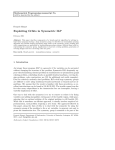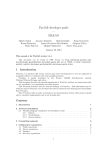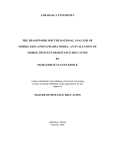Download Integer Set Library: Manual
Transcript
Integer Set Library: Manual
Version: isl-0.05.1
Sven Verdoolaege
January 5, 2011
Contents
1
User Manual
3
1.1 Introduction . . . . . . . . . . . . . . . . . . . . . . . . . . . . . . .
3
1.1.1 Backward Incompatible Changes . . . . . . . . . . . . . . .
3
1.2 Installation . . . . . . . . . . . . . . . . . . . . . . . . . . . . . . .
4
1.2.1 Installation from the git repository . . . . . . . . . . . . . . .
4
1.2.2 Common installation instructions . . . . . . . . . . . . . . .
4
1.3 Library . . . . . . . . . . . . . . . . . . . . . . . . . . . . . . . . .
5
1.3.1 Initialization . . . . . . . . . . . . . . . . . . . . . . . . . .
5
1.3.2 Integers . . . . . . . . . . . . . . . . . . . . . . . . . . . . .
6
1.3.3 Sets and Relations . . . . . . . . . . . . . . . . . . . . . . .
8
1.3.4 Memory Management . . . . . . . . . . . . . . . . . . . . .
8
1.3.5 Dimension Specifications . . . . . . . . . . . . . . . . . . .
9
1.3.6 Input and Output . . . . . . . . . . . . . . . . . . . . . . . . 11
1.3.7 Creating New Sets and Relations . . . . . . . . . . . . . . . . 14
1.3.8 Inspecting Sets and Relations . . . . . . . . . . . . . . . . . 18
1.3.9 Properties . . . . . . . . . . . . . . . . . . . . . . . . . . . . 22
1.3.10 Unary Operations . . . . . . . . . . . . . . . . . . . . . . . . 24
1.3.11 Binary Operations . . . . . . . . . . . . . . . . . . . . . . . 29
1.3.12 Matrices . . . . . . . . . . . . . . . . . . . . . . . . . . . . . 34
1.3.13 Points . . . . . . . . . . . . . . . . . . . . . . . . . . . . . . 34
1.3.14 Piecewise Quasipolynomials . . . . . . . . . . . . . . . . . . 36
1.3.15 Bounds on Piecewise Quasipolynomials and Piecewise Quasipolynomial Reductions . . . . . . . . . . . . . . . . . . . . . . . 41
1.3.16 Dependence Analysis . . . . . . . . . . . . . . . . . . . . . . 45
1.3.17 Parametric Vertex Enumeration . . . . . . . . . . . . . . . . 47
1.4 Applications . . . . . . . . . . . . . . . . . . . . . . . . . . . . . . . 48
1.4.1 isl polyhedron sample . . . . . . . . . . . . . . . . . . . 48
1.4.2 isl pip . . . . . . . . . . . . . . . . . . . . . . . . . . . . 48
1.4.3 isl polyhedron minimize . . . . . . . . . . . . . . . . . . 48
1.4.4 isl polytope scan . . . . . . . . . . . . . . . . . . . . . . 48
1.5 isl-polylib . . . . . . . . . . . . . . . . . . . . . . . . . . . . . . 49
1
2
Implementation Details
2.1 Sets and Relations . . . . . . . . . . . . . . . . . . . . . . .
2.2 Simple Hull . . . . . . . . . . . . . . . . . . . . . . . . . .
2.3 Coalescing . . . . . . . . . . . . . . . . . . . . . . . . . . .
2.4 Transitive Closure . . . . . . . . . . . . . . . . . . . . . . .
2.4.1 Introduction . . . . . . . . . . . . . . . . . . . . . .
2.4.2 Computing an Approximation of Rk . . . . . . . . .
2.4.3 Checking Exactness . . . . . . . . . . . . . . . . .
2.4.4 Decomposing R into strongly connected components
2.4.5 Partitioning the domains and ranges of R . . . . . .
2.4.6 Incremental Computation . . . . . . . . . . . . . . .
2.4.7 An Omega-like implementation . . . . . . . . . . . .
References
.
.
.
.
.
.
.
.
.
.
.
.
.
.
.
.
.
.
.
.
.
.
.
.
.
.
.
.
.
.
.
.
.
.
.
.
.
.
.
.
.
.
.
.
.
.
.
.
.
.
.
.
.
.
.
50
50
51
52
52
52
53
55
56
59
61
62
64
2
Chapter 1
User Manual
1.1
Introduction
isl is a thread-safe C library for manipulating sets and relations of integer points
bounded by affine constraints. The descriptions of the sets and relations may involve
both parameters and existentially quantified variables. All computations are performed
in exact integer arithmetic using GMP. The isl library offers functionality that is similar
to that offered by the Omega and Omega+ libraries, but the underlying algorithms are in
most cases completely different.
The library is by no means complete and some fairly basic functionality is still
missing. Still, even in its current form, the library has been successfully used as a
backend polyhedral library for the polyhedral scanner CLooG and as part of an equivalence checker of static affine programs. For bug reports, feature requests and questions,
visit the the discussion group at http://groups.google.com/group/isl-development.
1.1.1
Backward Incompatible Changes
Changes since isl-0.02
• The old printing functions have been deprecated and replaced by isl printer
functions, see Input and Output.
• Most functions related to dependence analysis have acquired an extra must argument. To obtain the old behavior, this argument should be given the value 1.
See Dependence Analysis.
Changes since isl-0.03
• The function isl pw qpolynomial fold add has been renamed to isl pw qpolynomial fold fold.
Similarly, isl union pw qpolynomial fold add has been renamed to isl union pw qpolynomial fold fold
3
Changes since isl-0.04
• All header files have been renamed from isl header.h to isl/header.h.
1.2
Installation
The source of isl can be obtained either as a tarball or from the git repository. Both
are available from http://freshmeat.net/projects/isl/. The installation process depends
on how you obtained the source.
1.2.1
Installation from the git repository
1. Clone or update the repository
The first time the source is obtained, you need to clone the repository.
git clone git://repo.or.cz/isl.git
To obtain updates, you need to pull in the latest changes
git pull
2. Generate configure
./autogen.sh
After performing the above steps, continue with the Common installation instructions.
1.2.2
Common installation instructions
1. Obtain GMP
Building isl requires GMP, including its headers files. Your distribution may not
provide these header files by default and you may need to install a package called
gmp-devel or something similar. Alternatively, GMP can be built from source,
available from http://gmplib.org/.
2. Configure
isl uses the standard autoconf configure script. To run it, just type
./configure
optionally followed by some configure options. A complete list of options can
be obtained by running
./configure --help
4
Below we discuss some of the more common options.
isl can optionally use piplib, but no piplib functionality is currently used
by default. The --with-piplib option can be used to specify which piplib
library to use, either an installed version (system), an externally built version
(build) or no version (no). The option build is mostly useful in configure
scripts of larger projects that bundle both isl and piplib.
--prefix
Installation prefix for isl
--with-gmp-prefix
Installation prefix for GMP (architecture-independent files).
--with-gmp-exec-prefix
Installation prefix for GMP (architecture-dependent files).
--with-piplib
Which copy of piplib to use, either no (default), system or build.
--with-piplib-prefix
Installation prefix for system piplib (architecture-independent files).
--with-piplib-exec-prefix
Installation prefix for system piplib (architecture-dependent files).
--with-piplib-builddir
Location where build piplib was built.
3. Compile
make
4. Install (optional)
make install
1.3
1.3.1
Library
Initialization
All manipulations of integer sets and relations occur within the context of an isl ctx.
A given isl ctx can only be used within a single thread. All arguments of a function
are required to have been allocated within the same context. There are currently no
functions available for moving an object from one isl ctx to another isl ctx. This
means that there is currently no way of safely moving an object from one thread to
another, unless the whole isl ctx is moved.
An isl ctx can be allocated using isl ctx alloc and freed using isl ctx free.
All objects allocated within an isl ctx should be freed before the isl ctx itself is
freed.
isl_ctx *isl_ctx_alloc();
void isl_ctx_free(isl_ctx *ctx);
5
1.3.2
Integers
All operations on integers, mainly the coefficients of the constraints describing the sets
and relations, are performed in exact integer arithmetic using GMP. However, to allow
future versions of isl to optionally support fixed integer arithmetic, all calls to GMP
are wrapped inside isl specific macros. The basic type is isl int and the operations
below are available on this type. The meanings of these operations are essentially the
same as their GMP mpz counterparts. As always with GMP types, isl ints need to be
initialized with isl int init before they can be used and they need to be released
with isl int clear after the last use. The user should not assume that an isl int
is represented as a mpz t, but should instead explicitly convert between mpz ts and
isl ints using isl int set gmp and isl int get gmp whenever a mpz t is required.
isl int init(i)
isl int clear(i)
isl int set(r,i)
isl int set si(r,i)
isl int set gmp(r,g)
isl int get gmp(i,g)
isl int abs(r,i)
isl int neg(r,i)
isl int swap(i,j)
isl int swap or set(i,j)
isl int add ui(r,i,j)
isl int sub ui(r,i,j)
isl int add(r,i,j)
isl int sub(r,i,j)
isl int mul(r,i,j)
isl int mul ui(r,i,j)
isl int addmul(r,i,j)
isl int submul(r,i,j)
isl int gcd(r,i,j)
isl int lcm(r,i,j)
6
isl int divexact(r,i,j)
isl int cdiv q(r,i,j)
isl int fdiv q(r,i,j)
isl int fdiv r(r,i,j)
isl int fdiv q ui(r,i,j)
isl int read(r,s)
isl int print(out,i,width)
isl int sgn(i)
isl int cmp(i,j)
isl int cmp si(i,si)
isl int eq(i,j)
isl int ne(i,j)
isl int lt(i,j)
isl int le(i,j)
isl int gt(i,j)
isl int ge(i,j)
isl int abs eq(i,j)
isl int abs ne(i,j)
isl int abs lt(i,j)
isl int abs gt(i,j)
isl int abs ge(i,j)
isl int is zero(i)
isl int is one(i)
isl int is negone(i)
isl int is pos(i)
isl int is neg(i)
isl int is nonpos(i)
isl int is nonneg(i)
isl int is divisible by(i,j)
7
1.3.3
Sets and Relations
isl uses six types of objects for representing sets and relations, isl basic set,
isl basic map, isl set, isl map, isl union set and isl union map. isl basic set
and isl basic map represent sets and relations that can be described as a conjunction
of affine constraints, while isl set and isl map represent unions of isl basic sets
and isl basic maps, respectively. However, all isl basic sets or isl basic maps
in the union need to have the same dimension. isl union sets and isl union maps
represent unions of isl sets or isl maps of different dimensions, where dimensions
with different space names (see Dimension Specifications) are considered different as
well. The difference between sets and relations (maps) is that sets have one set of variables, while relations have two sets of variables, input variables and output variables.
1.3.4
Memory Management
Since a high-level operation on sets and/or relations usually involves several substeps
and since the user is usually not interested in the intermediate results, most functions
that return a new object will also release all the objects passed as arguments. If the user
still wants to use one or more of these arguments after the function call, she should pass
along a copy of the object rather than the object itself. The user is then responsible for
make sure that the original object gets used somewhere else or is explicitly freed.
The arguments and return values of all documents functions are annotated to make
clear which arguments are released and which arguments are preserved. In particular,
the following annotations are used
isl give
isl give means that a new object is returned. The user should make sure that
the returned pointer is used exactly once as a value for an isl take argument.
In between, it can be used as a value for as many isl keep arguments as the
user likes. There is one exception, and that is the case where the pointer returned
is NULL. Is this case, the user is free to use it as an isl take argument or not.
isl take
isl take means that the object the argument points to is taken over by the
function and may no longer be used by the user as an argument to any other
function. The pointer value must be one returned by a function returning an
isl give pointer. If the user passes in a NULL value, then this will be treated
as an error in the sense that the function will not perform its usual operation.
However, it will still make sure that all the the other isl take arguments are
released.
isl keep
isl keep means that the function will only use the object temporarily. After
the function has finished, the user can still use it as an argument to other functions. A NULL value will be treated in the same way as a NULL value for an
isl take argument.
8
1.3.5
Dimension Specifications
Whenever a new set or relation is created from scratch, its dimension needs to be specified using an isl dim.
#include <isl/dim.h>
__isl_give isl_dim *isl_dim_alloc(isl_ctx *ctx,
unsigned nparam, unsigned n_in, unsigned n_out);
__isl_give isl_dim *isl_dim_set_alloc(isl_ctx *ctx,
unsigned nparam, unsigned dim);
__isl_give isl_dim *isl_dim_copy(__isl_keep isl_dim *dim);
void isl_dim_free(__isl_take isl_dim *dim);
unsigned isl_dim_size(__isl_keep isl_dim *dim,
enum isl_dim_type type);
The dimension specification used for creating a set needs to be created using isl dim set alloc,
while that for creating a relation needs to be created using isl dim alloc. isl dim size
can be used to find out the number of dimensions of each type in a dimension specification, where type may be isl dim param, isl dim in (only for relations), isl dim out
(only for relations), isl dim set (only for sets) or isl dim all.
It is often useful to create objects that live in the same space as some other object.
This can be accomplished by creating the new objects (see Creating New Sets and
Relations or Creating New (Piecewise) Quasipolynomials) based on the dimension
specification of the original object.
#include <isl/set.h>
__isl_give isl_dim *isl_basic_set_get_dim(
__isl_keep isl_basic_set *bset);
__isl_give isl_dim *isl_set_get_dim(__isl_keep isl_set *set);
#include <isl/union_set.h>
__isl_give isl_dim *isl_union_set_get_dim(
__isl_keep isl_union_set *uset);
#include <isl/map.h>
__isl_give isl_dim *isl_basic_map_get_dim(
__isl_keep isl_basic_map *bmap);
__isl_give isl_dim *isl_map_get_dim(__isl_keep isl_map *map);
#include <isl/union_map.h>
__isl_give isl_dim *isl_union_map_get_dim(
__isl_keep isl_union_map *umap);
#include <isl/polynomial.h>
__isl_give isl_dim *isl_qpolynomial_get_dim(
__isl_keep isl_qpolynomial *qp);
__isl_give isl_dim *isl_pw_qpolynomial_get_dim(
__isl_keep isl_pw_qpolynomial *pwqp);
9
__isl_give isl_dim
__isl_keep
__isl_give isl_dim
__isl_keep
*isl_union_pw_qpolynomial_get_dim(
isl_union_pw_qpolynomial *upwqp);
*isl_union_pw_qpolynomial_fold_get_dim(
isl_union_pw_qpolynomial_fold *upwf);
The names of the individual dimensions may be set or read off using the following
functions.
#include <isl/dim.h>
__isl_give isl_dim *isl_dim_set_name(__isl_take isl_dim *dim,
enum isl_dim_type type, unsigned pos,
__isl_keep const char *name);
__isl_keep const char *isl_dim_get_name(__isl_keep isl_dim *dim,
enum isl_dim_type type, unsigned pos);
Note that isl dim get name returns a pointer to some internal data structure, so
the result can only be used while the corresponding isl dim is alive. Also note that every function that operates on two sets or relations requires that both arguments have the
same parameters. This also means that if one of the arguments has named parameters,
then the other needs to have named parameters too and the names need to match. Pairs
of isl union set and/or isl union map arguments may have different parameters
(as long as they are named), in which case the result will have as parameters the union
of the parameters of the arguments.
The names of entire spaces may be set or read off using the following functions.
#include <isl/dim.h>
__isl_give isl_dim *isl_dim_set_tuple_name(
__isl_take isl_dim *dim,
enum isl_dim_type type, const char *s);
const char *isl_dim_get_tuple_name(__isl_keep isl_dim *dim,
enum isl_dim_type type);
The dim argument needs to be one of isl dim in, isl dim out or isl dim set.
As with isl dim get name, the isl dim get tuple name function returns a pointer
to some internal data structure. Binary operations require the corresponding spaces of
their arguments to have the same name.
Spaces can be nested. In particular, the domain of a set or the domain or range of a
relation can be a nested relation. The following functions can be used to construct and
deconstruct such nested dimension specifications.
#include <isl/dim.h>
int isl_dim_is_wrapping(__isl_keep isl_dim *dim);
__isl_give isl_dim *isl_dim_wrap(__isl_take isl_dim *dim);
__isl_give isl_dim *isl_dim_unwrap(__isl_take isl_dim *dim);
The input to isl dim is wrapping and isl dim unwrap should be the dimension specification of a set, while that of isl dim wrap should be the dimension specification of a relation. Conversely, the output of isl dim unwrap is the dimension
10
specification of a relation, while that of isl dim wrap is the dimension specification
of a set.
Dimension specifications can be created from other dimension specifications using
the following functions.
__isl_give isl_dim *isl_dim_domain(__isl_take isl_dim *dim);
__isl_give isl_dim *isl_dim_from_domain(__isl_take isl_dim *dim);
__isl_give isl_dim *isl_dim_range(__isl_take isl_dim *dim);
__isl_give isl_dim *isl_dim_from_range(__isl_take isl_dim *dim);
__isl_give isl_dim *isl_dim_reverse(__isl_take isl_dim *dim);
__isl_give isl_dim *isl_dim_join(__isl_take isl_dim *left,
__isl_take isl_dim *right);
__isl_give isl_dim *isl_dim_insert(__isl_take isl_dim *dim,
enum isl_dim_type type, unsigned pos, unsigned n);
__isl_give isl_dim *isl_dim_add(__isl_take isl_dim *dim,
enum isl_dim_type type, unsigned n);
__isl_give isl_dim *isl_dim_drop(__isl_take isl_dim *dim,
enum isl_dim_type type, unsigned first, unsigned n);
Note that if dimensions are added or removed from a space, then the name and the
internal structure are lost.
1.3.6
Input and Output
isl supports its own input/output format, which is similar to the Omega format, but
also supports the PolyLib format in some cases.
isl format
The isl format is similar to that of Omega, but has a different syntax for describing the
parameters and allows for the definition of an existentially quantified variable as the
integer division of an affine expression. For example, the set of integers i between 0
and n such that i % 10 <= 6 can be described as
[n] -> { [i] : exists (a = [i/10] : 0 <= i and i <= n and
i - 10 a <= 6) }
A set or relation can have several disjuncts, separated by the keyword or. Each
disjunct is either a conjunction of constraints or a projection (exists) of a conjunction
of constraints. The constraints are separated by the keyword and.
PolyLib format
If the represented set is a union, then the first line contains a single number representing
the number of disjuncts. Otherwise, a line containing the number 1 is optional.
Each disjunct is represented by a matrix of constraints. The first line contains two
numbers representing the number of rows and columns, where the number of rows is
11
equal to the number of constraints and the number of columns is equal to two plus
the number of variables. The following lines contain the actual rows of the constraint
matrix. In each row, the first column indicates whether the constraint is an equality (0)
or inequality (1). The final column corresponds to the constant term.
If the set is parametric, then the coefficients of the parameters appear in the last
columns before the constant column. The coefficients of any existentially quantified
variables appear between those of the set variables and those of the parameters.
Extended PolyLib format
The extended PolyLib format is nearly identical to the PolyLib format. The only
difference is that the line containing the number of rows and columns of a constraint
matrix also contains four additional numbers: the number of output dimensions, the
number of input dimensions, the number of local dimensions (i.e., the number of existentially quantified variables) and the number of parameters. For sets, the number
of “output” dimensions is equal to the number of set dimensions, while the number of
“input” dimensions is zero.
Input
#include <isl/set.h>
__isl_give isl_basic_set *isl_basic_set_read_from_file(
isl_ctx *ctx, FILE *input, int nparam);
__isl_give isl_basic_set *isl_basic_set_read_from_str(
isl_ctx *ctx, const char *str, int nparam);
__isl_give isl_set *isl_set_read_from_file(isl_ctx *ctx,
FILE *input, int nparam);
__isl_give isl_set *isl_set_read_from_str(isl_ctx *ctx,
const char *str, int nparam);
#include <isl/map.h>
__isl_give isl_basic_map *isl_basic_map_read_from_file(
isl_ctx *ctx, FILE *input, int nparam);
__isl_give isl_basic_map *isl_basic_map_read_from_str(
isl_ctx *ctx, const char *str, int nparam);
__isl_give isl_map *isl_map_read_from_file(
struct isl_ctx *ctx, FILE *input, int nparam);
__isl_give isl_map *isl_map_read_from_str(isl_ctx *ctx,
const char *str, int nparam);
#include <isl/union_set.h>
__isl_give isl_union_set *isl_union_set_read_from_str(
struct isl_ctx *ctx, const char *str);
#include <isl/union_map.h>
__isl_give isl_union_map *isl_union_map_read_from_str(
struct isl_ctx *ctx, const char *str);
12
The input format is autodetected and may be either the PolyLib format or the
isl format. nparam specifies how many of the final columns in the PolyLib format
correspond to parameters. If input is given in the isl format, then the number of
parameters needs to be equal to nparam. If nparam is negative, then any number
of parameters is accepted in the isl format and zero parameters are assumed in the
PolyLib format.
Output
Before anything can be printed, an isl printer needs to be created.
__isl_give isl_printer *isl_printer_to_file(isl_ctx *ctx,
FILE *file);
__isl_give isl_printer *isl_printer_to_str(isl_ctx *ctx);
void isl_printer_free(__isl_take isl_printer *printer);
__isl_give char *isl_printer_get_str(
__isl_keep isl_printer *printer);
The behavior of the printer can be modified in various ways
__isl_give isl_printer *isl_printer_set_output_format(
__isl_take isl_printer *p, int output_format);
__isl_give isl_printer *isl_printer_set_indent(
__isl_take isl_printer *p, int indent);
__isl_give isl_printer *isl_printer_set_prefix(
__isl_take isl_printer *p, const char *prefix);
__isl_give isl_printer *isl_printer_set_suffix(
__isl_take isl_printer *p, const char *suffix);
The output format may be either ISL FORMAT ISL, ISL FORMAT OMEGA, ISL FORMAT POLYLIB,
ISL FORMAT EXT POLYLIB or ISL FORMAT LATEX and defaults to ISL FORMAT ISL.
Each line in the output is indented by indent spaces (default: 0), prefixed by prefix
and suffixed by suffix. In the PolyLib format output, the coefficients of the existentially quantified variables appear between those of the set variables and those of the
parameters.
To actually print something, use
#include <isl/set.h>
__isl_give isl_printer *isl_printer_print_basic_set(
__isl_take isl_printer *printer,
__isl_keep isl_basic_set *bset);
__isl_give isl_printer *isl_printer_print_set(
__isl_take isl_printer *printer,
__isl_keep isl_set *set);
#include <isl/map.h>
__isl_give isl_printer *isl_printer_print_basic_map(
13
__isl_take isl_printer *printer,
__isl_keep isl_basic_map *bmap);
__isl_give isl_printer *isl_printer_print_map(
__isl_take isl_printer *printer,
__isl_keep isl_map *map);
#include <isl/union_set.h>
__isl_give isl_printer *isl_printer_print_union_set(
__isl_take isl_printer *p,
__isl_keep isl_union_set *uset);
#include <isl/union_map.h>
__isl_give isl_printer *isl_printer_print_union_map(
__isl_take isl_printer *p,
__isl_keep isl_union_map *umap);
When called on a file printer, the following function flushes the file. When called
on a string printer, the buffer is cleared.
__isl_give isl_printer *isl_printer_flush(
__isl_take isl_printer *p);
1.3.7
Creating New Sets and Relations
isl has functions for creating some standard sets and relations.
• Empty sets and relations
__isl_give isl_basic_set *isl_basic_set_empty(
__isl_take isl_dim *dim);
__isl_give isl_basic_map *isl_basic_map_empty(
__isl_take isl_dim *dim);
__isl_give isl_set *isl_set_empty(
__isl_take isl_dim *dim);
__isl_give isl_map *isl_map_empty(
__isl_take isl_dim *dim);
__isl_give isl_union_set *isl_union_set_empty(
__isl_take isl_dim *dim);
__isl_give isl_union_map *isl_union_map_empty(
__isl_take isl_dim *dim);
For isl union sets and isl union maps, the dimensions specification is only
used to specify the parameters.
• Universe sets and relations
14
__isl_give isl_basic_set *isl_basic_set_universe(
__isl_take isl_dim *dim);
__isl_give isl_basic_map *isl_basic_map_universe(
__isl_take isl_dim *dim);
__isl_give isl_set *isl_set_universe(
__isl_take isl_dim *dim);
__isl_give isl_map *isl_map_universe(
__isl_take isl_dim *dim);
• Identity relations
__isl_give isl_basic_map *isl_basic_map_identity(
__isl_take isl_dim *set_dim);
__isl_give isl_map *isl_map_identity(
__isl_take isl_dim *set_dim);
These functions take a dimension specification for a set and return an identity
relation between two such sets.
• Lexicographic order
__isl_give isl_map
__isl_take
__isl_give isl_map
__isl_take
__isl_give isl_map
__isl_take
__isl_give isl_map
__isl_take
__isl_give isl_map
__isl_take
__isl_give isl_map
__isl_take
__isl_give isl_map
__isl_take
__isl_give isl_map
__isl_take
*isl_map_lex_lt(
isl_dim *set_dim);
*isl_map_lex_le(
isl_dim *set_dim);
*isl_map_lex_gt(
isl_dim *set_dim);
*isl_map_lex_ge(
isl_dim *set_dim);
*isl_map_lex_lt_first(
isl_dim *dim, unsigned
*isl_map_lex_le_first(
isl_dim *dim, unsigned
*isl_map_lex_gt_first(
isl_dim *dim, unsigned
*isl_map_lex_ge_first(
isl_dim *dim, unsigned
n);
n);
n);
n);
The first four functions take a dimension specification for a set and return relations that express that the elements in the domain are lexicographically less
(isl map lex lt), less or equal (isl map lex le), greater (isl map lex gt)
or greater or equal (isl map lex ge) than the elements in the range. The last
four functions take a dimension specification for a map and return relations
that express that the first n dimensions in the domain are lexicographically less
(isl map lex lt first), less or equal (isl map lex le first), greater (isl map lex gt first)
or greater or equal (isl map lex ge first) than the first n dimensions in the
range.
15
A basic set or relation can be converted to a set or relation using the following
functions.
__isl_give isl_set
__isl_take
__isl_give isl_map
__isl_take
*isl_set_from_basic_set(
isl_basic_set *bset);
*isl_map_from_basic_map(
isl_basic_map *bmap);
Sets and relations can be converted to union sets and relations using the following
functions.
__isl_give isl_union_map *isl_union_map_from_map(
__isl_take isl_map *map);
__isl_give isl_union_set *isl_union_set_from_set(
__isl_take isl_set *set);
Sets and relations can be copied and freed again using the following functions.
__isl_give isl_basic_set *isl_basic_set_copy(
__isl_keep isl_basic_set *bset);
__isl_give isl_set *isl_set_copy(__isl_keep isl_set *set);
__isl_give isl_union_set *isl_union_set_copy(
__isl_keep isl_union_set *uset);
__isl_give isl_basic_map *isl_basic_map_copy(
__isl_keep isl_basic_map *bmap);
__isl_give isl_map *isl_map_copy(__isl_keep isl_map *map);
__isl_give isl_union_map *isl_union_map_copy(
__isl_keep isl_union_map *umap);
void isl_basic_set_free(__isl_take isl_basic_set *bset);
void isl_set_free(__isl_take isl_set *set);
void isl_union_set_free(__isl_take isl_union_set *uset);
void isl_basic_map_free(__isl_take isl_basic_map *bmap);
void isl_map_free(__isl_take isl_map *map);
void isl_union_map_free(__isl_take isl_union_map *umap);
Other sets and relations can be constructed by starting from a universe set or relation, adding equality and/or inequality constraints and then projecting out the existentially quantified variables, if any. Constraints can be constructed, manipulated and
added to basic sets and relations using the following functions.
#include <isl/constraint.h>
__isl_give isl_constraint *isl_equality_alloc(
__isl_take isl_dim *dim);
__isl_give isl_constraint *isl_inequality_alloc(
__isl_take isl_dim *dim);
void isl_constraint_set_constant(
__isl_keep isl_constraint *constraint, isl_int v);
16
void isl_constraint_set_coefficient(
__isl_keep isl_constraint *constraint,
enum isl_dim_type type, int pos, isl_int v);
__isl_give isl_basic_map *isl_basic_map_add_constraint(
__isl_take isl_basic_map *bmap,
__isl_take isl_constraint *constraint);
__isl_give isl_basic_set *isl_basic_set_add_constraint(
__isl_take isl_basic_set *bset,
__isl_take isl_constraint *constraint);
For example, to create a set containing the even integers between 10 and 42, you
would use the following code.
isl_int v;
struct isl_dim *dim;
struct isl_constraint *c;
struct isl_basic_set *bset;
isl_int_init(v);
dim = isl_dim_set_alloc(ctx, 0, 2);
bset = isl_basic_set_universe(isl_dim_copy(dim));
c = isl_equality_alloc(isl_dim_copy(dim));
isl_int_set_si(v, -1);
isl_constraint_set_coefficient(c, isl_dim_set, 0, v);
isl_int_set_si(v, 2);
isl_constraint_set_coefficient(c, isl_dim_set, 1, v);
bset = isl_basic_set_add_constraint(bset, c);
c = isl_inequality_alloc(isl_dim_copy(dim));
isl_int_set_si(v, -10);
isl_constraint_set_constant(c, v);
isl_int_set_si(v, 1);
isl_constraint_set_coefficient(c, isl_dim_set, 0, v);
bset = isl_basic_set_add_constraint(bset, c);
c = isl_inequality_alloc(dim);
isl_int_set_si(v, 42);
isl_constraint_set_constant(c, v);
isl_int_set_si(v, -1);
isl_constraint_set_coefficient(c, isl_dim_set, 0, v);
bset = isl_basic_set_add_constraint(bset, c);
bset = isl_basic_set_project_out(bset, isl_dim_set, 1, 1);
isl_int_clear(v);
Or, alternatively,
17
struct isl_basic_set *bset;
bset = isl_basic_set_read_from_str(ctx,
"{[i] : exists (a : i = 2a and i >= 10 and i <= 42)}", -1);
A basic set or relation can also be constructed from two matrices describing the
equalities and the inequalities.
__isl_give isl_basic_set *isl_basic_set_from_constraint_matrices(
__isl_take isl_dim *dim,
__isl_take isl_mat *eq, __isl_take isl_mat *ineq,
enum isl_dim_type c1,
enum isl_dim_type c2, enum isl_dim_type c3,
enum isl_dim_type c4);
__isl_give isl_basic_map *isl_basic_map_from_constraint_matrices(
__isl_take isl_dim *dim,
__isl_take isl_mat *eq, __isl_take isl_mat *ineq,
enum isl_dim_type c1,
enum isl_dim_type c2, enum isl_dim_type c3,
enum isl_dim_type c4, enum isl_dim_type c5);
The isl dim type arguments indicate the order in which different kinds of variables appear in the input matrices and should be a permutation of isl dim cst, isl dim param,
isl dim set and isl dim div for sets and of isl dim cst, isl dim param, isl dim in,
isl dim out and isl dim div for relations.
1.3.8
Inspecting Sets and Relations
Usually, the user should not have to care about the actual constraints of the sets and
maps, but should instead apply the abstract operations explained in the following sections. Occasionally, however, it may be required to inspect the individual coefficients
of the constraints. This section explains how to do so. In these cases, it may also be
useful to have isl compute an explicit representation of the existentially quantified
variables.
__isl_give isl_set *isl_set_compute_divs(
__isl_take isl_set *set);
__isl_give isl_map *isl_map_compute_divs(
__isl_take isl_map *map);
__isl_give isl_union_set *isl_union_set_compute_divs(
__isl_take isl_union_set *uset);
__isl_give isl_union_map *isl_union_map_compute_divs(
__isl_take isl_union_map *umap);
This explicit representation defines the existentially quantified variables as integer
divisions of the other variables, possibly including earlier existentially quantified variables. An explicitly represented existentially quantified variable therefore has a unique
18
value when the values of the other variables are known. If, furthermore, the same existentials, i.e., existentials with the same explicit representations, should appear in the
same order in each of the disjuncts of a set or map, then the user should call either of
the following functions.
__isl_give isl_set
__isl_take
__isl_give isl_map
__isl_take
*isl_set_align_divs(
isl_set *set);
*isl_map_align_divs(
isl_map *map);
Alternatively, the existentially quantified variables can be removed using the following functions, which compute an overapproximation.
__isl_give isl_basic_set *isl_basic_set_remove_divs(
__isl_take isl_basic_set *bset);
__isl_give isl_basic_map *isl_basic_map_remove_divs(
__isl_take isl_basic_map *bmap);
__isl_give isl_set *isl_set_remove_divs(
__isl_take isl_set *set);
To iterate over all the sets or maps in a union set or map, use
int isl_union_set_foreach_set(__isl_keep isl_union_set *uset,
int (*fn)(__isl_take isl_set *set, void *user),
void *user);
int isl_union_map_foreach_map(__isl_keep isl_union_map *umap,
int (*fn)(__isl_take isl_map *map, void *user),
void *user);
The number of sets or maps in a union set or map can be obtained from
int isl_union_set_n_set(__isl_keep isl_union_set *uset);
int isl_union_map_n_map(__isl_keep isl_union_map *umap);
To extract the set or map from a union with a given dimension specification, use
__isl_give isl_set
__isl_keep
__isl_take
__isl_give isl_map
__isl_keep
__isl_take
*isl_union_set_extract_set(
isl_union_set *uset,
isl_dim *dim);
*isl_union_map_extract_map(
isl_union_map *umap,
isl_dim *dim);
To iterate over all the basic sets or maps in a set or map, use
int isl_set_foreach_basic_set(__isl_keep isl_set *set,
int (*fn)(__isl_take isl_basic_set *bset, void *user),
void *user);
int isl_map_foreach_basic_map(__isl_keep isl_map *map,
int (*fn)(__isl_take isl_basic_map *bmap, void *user),
void *user);
19
The callback function fn should return 0 if successful and -1 if an error occurs. In
the latter case, or if any other error occurs, the above functions will return -1.
It should be noted that isl does not guarantee that the basic sets or maps passed
to fn are disjoint. If this is required, then the user should call one of the following
functions first.
__isl_give isl_set
__isl_take
__isl_give isl_map
__isl_take
*isl_set_make_disjoint(
isl_set *set);
*isl_map_make_disjoint(
isl_map *map);
The number of basic sets in a set can be obtained from
int isl_set_n_basic_set(__isl_keep isl_set *set);
To iterate over the constraints of a basic set or map, use
#include <isl/constraint.h>
int isl_basic_map_foreach_constraint(
__isl_keep isl_basic_map *bmap,
int (*fn)(__isl_take isl_constraint *c, void *user),
void *user);
void isl_constraint_free(struct isl_constraint *c);
Again, the callback function fn should return 0 if successful and -1 if an error
occurs. In the latter case, or if any other error occurs, the above functions will return
-1. The constraint c represents either an equality or an inequality. Use the following
function to find out whether a constraint represents an equality. If not, it represents an
inequality.
int isl_constraint_is_equality(
__isl_keep isl_constraint *constraint);
The coefficients of the constraints can be inspected using the following functions.
void isl_constraint_get_constant(
__isl_keep isl_constraint *constraint, isl_int *v);
void isl_constraint_get_coefficient(
__isl_keep isl_constraint *constraint,
enum isl_dim_type type, int pos, isl_int *v);
The explicit representations of the existentially quantified variables can be inspected
using the following functions. Note that the user is only allowed to use these functions if the inspected set or map is the result of a call to isl set compute divs or
isl map compute divs.
20
__isl_give isl_div *isl_constraint_div(
__isl_keep isl_constraint *constraint, int pos);
void isl_div_get_constant(__isl_keep isl_div *div,
isl_int *v);
void isl_div_get_denominator(__isl_keep isl_div *div,
isl_int *v);
void isl_div_get_coefficient(__isl_keep isl_div *div,
enum isl_dim_type type, int pos, isl_int *v);
To obtain the constraints of a basic set or map in matrix form, use the following
functions.
__isl_give isl_mat *isl_basic_set_equalities_matrix(
__isl_keep isl_basic_set *bset,
enum isl_dim_type c1, enum isl_dim_type c2,
enum isl_dim_type c3, enum isl_dim_type c4);
__isl_give isl_mat *isl_basic_set_inequalities_matrix(
__isl_keep isl_basic_set *bset,
enum isl_dim_type c1, enum isl_dim_type c2,
enum isl_dim_type c3, enum isl_dim_type c4);
__isl_give isl_mat *isl_basic_map_equalities_matrix(
__isl_keep isl_basic_map *bmap,
enum isl_dim_type c1,
enum isl_dim_type c2, enum isl_dim_type c3,
enum isl_dim_type c4, enum isl_dim_type c5);
__isl_give isl_mat *isl_basic_map_inequalities_matrix(
__isl_keep isl_basic_map *bmap,
enum isl_dim_type c1,
enum isl_dim_type c2, enum isl_dim_type c3,
enum isl_dim_type c4, enum isl_dim_type c5);
The isl dim type arguments dictate the order in which different kinds of variables appear in the resulting matrix and should be a permutation of isl dim cst,
isl dim param, isl dim in, isl dim out and isl dim div.
The names of the domain and range spaces of a set or relation can be read off using
the following functions.
const char *isl_set_get_tuple_name(
__isl_keep isl_set *set);
const char *isl_basic_map_get_tuple_name(
__isl_keep isl_basic_map *bmap,
enum isl_dim_type type);
const char *isl_map_get_tuple_name(
__isl_keep isl_map *map,
enum isl_dim_type type);
21
As with isl dim get tuple name, the value returned points to an internal data
structure. The names of individual dimensions can be read off using the following
functions.
const char *isl_constraint_get_dim_name(
__isl_keep isl_constraint *constraint,
enum isl_dim_type type, unsigned pos);
const char *isl_set_get_dim_name(
__isl_keep isl_set *set,
enum isl_dim_type type, unsigned pos);
const char *isl_basic_map_get_dim_name(
__isl_keep isl_basic_map *bmap,
enum isl_dim_type type, unsigned pos);
const char *isl_map_get_dim_name(
__isl_keep isl_map *map,
enum isl_dim_type type, unsigned pos);
These functions are mostly useful to obtain the names of the parameters.
1.3.9
Properties
Unary Properties
• Emptiness
The following functions test whether the given set or relation contains any integer
points. The “fast” variants do not perform any computations, but simply check
if the given set or relation is already known to be empty.
int
int
int
int
int
int
int
int
int
isl_basic_set_fast_is_empty(__isl_keep isl_basic_set *bset);
isl_basic_set_is_empty(__isl_keep isl_basic_set *bset);
isl_set_is_empty(__isl_keep isl_set *set);
isl_union_set_is_empty(__isl_keep isl_union_set *uset);
isl_basic_map_fast_is_empty(__isl_keep isl_basic_map *bmap);
isl_basic_map_is_empty(__isl_keep isl_basic_map *bmap);
isl_map_fast_is_empty(__isl_keep isl_map *map);
isl_map_is_empty(__isl_keep isl_map *map);
isl_union_map_is_empty(__isl_keep isl_union_map *umap);
• Universality
int isl_basic_set_is_universe(__isl_keep isl_basic_set *bset);
int isl_basic_map_is_universe(__isl_keep isl_basic_map *bmap);
int isl_set_fast_is_universe(__isl_keep isl_set *set);
• Single-valuedness
int isl_map_is_single_valued(__isl_keep isl_map *map);
22
• Bijectivity
int isl_map_is_bijective(__isl_keep isl_map *map);
• Wrapping
The followning functions check whether the domain of the given (basic) set is a
wrapped relation.
int isl_basic_set_is_wrapping(
__isl_keep isl_basic_set *bset);
int isl_set_is_wrapping(__isl_keep isl_set *set);
Binary Properties
• Equality
int isl_set_fast_is_equal(__isl_keep isl_set *set1,
__isl_keep isl_set *set2);
int isl_set_is_equal(__isl_keep isl_set *set1,
__isl_keep isl_set *set2);
int isl_union_set_is_equal(
__isl_keep isl_union_set *uset1,
__isl_keep isl_union_set *uset2);
int isl_basic_map_is_equal(
__isl_keep isl_basic_map *bmap1,
__isl_keep isl_basic_map *bmap2);
int isl_map_is_equal(__isl_keep isl_map *map1,
__isl_keep isl_map *map2);
int isl_map_fast_is_equal(__isl_keep isl_map *map1,
__isl_keep isl_map *map2);
int isl_union_map_is_equal(
__isl_keep isl_union_map *umap1,
__isl_keep isl_union_map *umap2);
• Disjointness
int isl_set_fast_is_disjoint(__isl_keep isl_set *set1,
__isl_keep isl_set *set2);
• Subset
int isl_set_is_subset(__isl_keep isl_set *set1,
__isl_keep isl_set *set2);
int isl_set_is_strict_subset(
__isl_keep isl_set *set1,
__isl_keep isl_set *set2);
23
int isl_union_set_is_subset(
__isl_keep isl_union_set *uset1,
__isl_keep isl_union_set *uset2);
int isl_union_set_is_strict_subset(
__isl_keep isl_union_set *uset1,
__isl_keep isl_union_set *uset2);
int isl_basic_map_is_subset(
__isl_keep isl_basic_map *bmap1,
__isl_keep isl_basic_map *bmap2);
int isl_basic_map_is_strict_subset(
__isl_keep isl_basic_map *bmap1,
__isl_keep isl_basic_map *bmap2);
int isl_map_is_subset(
__isl_keep isl_map *map1,
__isl_keep isl_map *map2);
int isl_map_is_strict_subset(
__isl_keep isl_map *map1,
__isl_keep isl_map *map2);
int isl_union_map_is_subset(
__isl_keep isl_union_map *umap1,
__isl_keep isl_union_map *umap2);
int isl_union_map_is_strict_subset(
__isl_keep isl_union_map *umap1,
__isl_keep isl_union_map *umap2);
1.3.10
Unary Operations
• Complement
__isl_give isl_set *isl_set_complement(
__isl_take isl_set *set);
• Inverse map
__isl_give isl_basic_map *isl_basic_map_reverse(
__isl_take isl_basic_map *bmap);
__isl_give isl_map *isl_map_reverse(
__isl_take isl_map *map);
__isl_give isl_union_map *isl_union_map_reverse(
__isl_take isl_union_map *umap);
• Projection
__isl_give isl_basic_set *isl_basic_set_project_out(
__isl_take isl_basic_set *bset,
enum isl_dim_type type, unsigned first, unsigned n);
24
__isl_give isl_basic_map *isl_basic_map_project_out(
__isl_take isl_basic_map *bmap,
enum isl_dim_type type, unsigned first, unsigned n);
__isl_give isl_set *isl_set_project_out(__isl_take isl_set *set,
enum isl_dim_type type, unsigned first, unsigned n);
__isl_give isl_map *isl_map_project_out(__isl_take isl_map *map,
enum isl_dim_type type, unsigned first, unsigned n);
__isl_give isl_basic_set *isl_basic_map_domain(
__isl_take isl_basic_map *bmap);
__isl_give isl_basic_set *isl_basic_map_range(
__isl_take isl_basic_map *bmap);
__isl_give isl_set *isl_map_domain(
__isl_take isl_map *bmap);
__isl_give isl_set *isl_map_range(
__isl_take isl_map *map);
__isl_give isl_union_set *isl_union_map_domain(
__isl_take isl_union_map *umap);
__isl_give isl_union_set *isl_union_map_range(
__isl_take isl_union_map *umap);
__isl_give isl_basic_map *isl_basic_map_domain_map(
__isl_take isl_basic_map *bmap);
__isl_give isl_basic_map *isl_basic_map_range_map(
__isl_take isl_basic_map *bmap);
__isl_give isl_map *isl_map_domain_map(__isl_take isl_map *map);
__isl_give isl_map *isl_map_range_map(__isl_take isl_map *map);
__isl_give isl_union_map *isl_union_map_domain_map(
__isl_take isl_union_map *umap);
__isl_give isl_union_map *isl_union_map_range_map(
__isl_take isl_union_map *umap);
The functions above construct a (basic, regular or union) relation that maps (a
wrapped version of) the input relation to its domain or range.
• Identity
__isl_give isl_map *isl_set_identity(
__isl_take isl_set *set);
__isl_give isl_union_map *isl_union_set_identity(
__isl_take isl_union_set *uset);
Construct an identity relation on the given (union) set.
• Deltas
__isl_give isl_basic_set *isl_basic_map_deltas(
25
__isl_take isl_basic_map *bmap);
__isl_give isl_set *isl_map_deltas(__isl_take isl_map *map);
__isl_give isl_union_set *isl_union_map_deltas(
__isl_take isl_union_map *umap);
These functions return a (basic) set containing the differences between image
elements and corresponding domain elements in the input.
• Coalescing
Simplify the representation of a set or relation by trying to combine pairs of basic
sets or relations into a single basic set or relation.
__isl_give isl_set *isl_set_coalesce(__isl_take isl_set *set);
__isl_give isl_map *isl_map_coalesce(__isl_take isl_map *map);
__isl_give isl_union_set *isl_union_set_coalesce(
__isl_take isl_union_set *uset);
__isl_give isl_union_map *isl_union_map_coalesce(
__isl_take isl_union_map *umap);
• Convex hull
__isl_give isl_basic_set *isl_set_convex_hull(
__isl_take isl_set *set);
__isl_give isl_basic_map *isl_map_convex_hull(
__isl_take isl_map *map);
If the input set or relation has any existentially quantified variables, then the
result of these operations is currently undefined.
• Simple hull
__isl_give isl_basic_set *isl_set_simple_hull(
__isl_take isl_set *set);
__isl_give isl_basic_map *isl_map_simple_hull(
__isl_take isl_map *map);
These functions compute a single basic set or relation that contains the whole
input set or relation. In particular, the output is described by translates of the
constraints describing the basic sets or relations in the input.
(See Section 2.2.)
• Affine hull
__isl_give isl_basic_set *isl_basic_set_affine_hull(
__isl_take isl_basic_set *bset);
__isl_give isl_basic_set *isl_set_affine_hull(
26
__isl_take isl_set *set);
__isl_give isl_union_set *isl_union_set_affine_hull(
__isl_take isl_union_set *uset);
__isl_give isl_basic_map *isl_basic_map_affine_hull(
__isl_take isl_basic_map *bmap);
__isl_give isl_basic_map *isl_map_affine_hull(
__isl_take isl_map *map);
__isl_give isl_union_map *isl_union_map_affine_hull(
__isl_take isl_union_map *umap);
In case of union sets and relations, the affine hull is computed per space.
• Polyhedral hull
__isl_give isl_basic_set *isl_set_polyhedral_hull(
__isl_take isl_set *set);
__isl_give isl_basic_map *isl_map_polyhedral_hull(
__isl_take isl_map *map);
__isl_give isl_union_set *isl_union_set_polyhedral_hull(
__isl_take isl_union_set *uset);
__isl_give isl_union_map *isl_union_map_polyhedral_hull(
__isl_take isl_union_map *umap);
These functions compute a single basic set or relation not involving any existentially quantified variables that contains the whole input set or relation. In case of
union sets and relations, the polyhedral hull is computed per space.
• Power
__isl_give isl_map *isl_map_power(__isl_take isl_map *map,
unsigned param, int *exact);
Compute a parametric representation for all positive powers k of map. The power
k is equated to the parameter at position param. The result may be an overapproximation. If the result is exact, then *exact is set to 1. The current implementation only produces exact results for particular cases of piecewise translations (i.e., piecewise uniform dependences).
• Transitive closure
__isl_give isl_map *isl_map_transitive_closure(
__isl_take isl_map *map, int *exact);
__isl_give isl_union_map *isl_union_map_transitive_closure(
__isl_take isl_union_map *umap, int *exact);
Compute the transitive closure of map. The result may be an overapproximation.
If the result is known to be exact, then *exact is set to 1. The current implementation only produces exact results for particular cases of piecewise translations
(i.e., piecewise uniform dependences).
27
• Reaching path lengths
__isl_give isl_map *isl_map_reaching_path_lengths(
__isl_take isl_map *map, int *exact);
Compute a relation that maps each element in the range of map to the lengths of
all paths composed of edges in map that end up in the given element. The result
may be an overapproximation. If the result is known to be exact, then *exact
is set to 1. To compute the maximal path length, the resulting relation should
be postprocessed by isl map lexmax. In particular, if the input relation is a
dependence relation (mapping sources to sinks), then the maximal path length
corresponds to the free schedule. Note, however, that isl map lexmax expects
the maximum to be finite, so if the path lengths are unbounded (possibly due to
the overapproximation), then you will get an error message.
• Wrapping
__isl_give isl_basic_set *isl_basic_map_wrap(
__isl_take isl_basic_map *bmap);
__isl_give isl_set *isl_map_wrap(
__isl_take isl_map *map);
__isl_give isl_union_set *isl_union_map_wrap(
__isl_take isl_union_map *umap);
__isl_give isl_basic_map *isl_basic_set_unwrap(
__isl_take isl_basic_set *bset);
__isl_give isl_map *isl_set_unwrap(
__isl_take isl_set *set);
__isl_give isl_union_map *isl_union_set_unwrap(
__isl_take isl_union_set *uset);
• Flattening
Remove any internal structure of domain (and range) of the given set or relation.
If there is any such internal structure in the input, then the name of the space is
also removed.
__isl_give isl_set
__isl_take
__isl_give isl_map
__isl_take
*isl_set_flatten(
isl_set *set);
*isl_map_flatten(
isl_map *map);
__isl_give isl_map *isl_set_flatten_map(
__isl_take isl_set *set);
The function above constructs a relation that maps the input set to a flattened
version of the set.
28
• Dimension manipulation
__isl_give isl_set *isl_set_add_dims(
__isl_take isl_set *set,
enum isl_dim_type type, unsigned n);
__isl_give isl_map *isl_map_add_dims(
__isl_take isl_map *map,
enum isl_dim_type type, unsigned n);
It is usually not advisable to directly change the (input or output) space of a set
or a relation as this removes the name and the internal structure of the space.
However, the above functions can be useful to add new parameters.
1.3.11
Binary Operations
The two arguments of a binary operation not only need to live in the same isl ctx,
they currently also need to have the same (number of) parameters.
Basic Operations
• Intersection
__isl_give isl_basic_set *isl_basic_set_intersect(
__isl_take isl_basic_set *bset1,
__isl_take isl_basic_set *bset2);
__isl_give isl_set *isl_set_intersect(
__isl_take isl_set *set1,
__isl_take isl_set *set2);
__isl_give isl_union_set *isl_union_set_intersect(
__isl_take isl_union_set *uset1,
__isl_take isl_union_set *uset2);
__isl_give isl_basic_map *isl_basic_map_intersect_domain(
__isl_take isl_basic_map *bmap,
__isl_take isl_basic_set *bset);
__isl_give isl_basic_map *isl_basic_map_intersect_range(
__isl_take isl_basic_map *bmap,
__isl_take isl_basic_set *bset);
__isl_give isl_basic_map *isl_basic_map_intersect(
__isl_take isl_basic_map *bmap1,
__isl_take isl_basic_map *bmap2);
__isl_give isl_map *isl_map_intersect_domain(
__isl_take isl_map *map,
__isl_take isl_set *set);
__isl_give isl_map *isl_map_intersect_range(
__isl_take isl_map *map,
__isl_take isl_set *set);
29
__isl_give isl_map *isl_map_intersect(
__isl_take isl_map *map1,
__isl_take isl_map *map2);
__isl_give isl_union_map *isl_union_map_intersect_domain(
__isl_take isl_union_map *umap,
__isl_take isl_union_set *uset);
__isl_give isl_union_map *isl_union_map_intersect_range(
__isl_take isl_union_map *umap,
__isl_take isl_union_set *uset);
__isl_give isl_union_map *isl_union_map_intersect(
__isl_take isl_union_map *umap1,
__isl_take isl_union_map *umap2);
• Union
__isl_give isl_set *isl_basic_set_union(
__isl_take isl_basic_set *bset1,
__isl_take isl_basic_set *bset2);
__isl_give isl_map *isl_basic_map_union(
__isl_take isl_basic_map *bmap1,
__isl_take isl_basic_map *bmap2);
__isl_give isl_set *isl_set_union(
__isl_take isl_set *set1,
__isl_take isl_set *set2);
__isl_give isl_map *isl_map_union(
__isl_take isl_map *map1,
__isl_take isl_map *map2);
__isl_give isl_union_set *isl_union_set_union(
__isl_take isl_union_set *uset1,
__isl_take isl_union_set *uset2);
__isl_give isl_union_map *isl_union_map_union(
__isl_take isl_union_map *umap1,
__isl_take isl_union_map *umap2);
• Set difference
__isl_give isl_set *isl_set_subtract(
__isl_take isl_set *set1,
__isl_take isl_set *set2);
__isl_give isl_map *isl_map_subtract(
__isl_take isl_map *map1,
__isl_take isl_map *map2);
__isl_give isl_union_set *isl_union_set_subtract(
__isl_take isl_union_set *uset1,
__isl_take isl_union_set *uset2);
__isl_give isl_union_map *isl_union_map_subtract(
30
__isl_take isl_union_map *umap1,
__isl_take isl_union_map *umap2);
• Application
__isl_give isl_basic_set *isl_basic_set_apply(
__isl_take isl_basic_set *bset,
__isl_take isl_basic_map *bmap);
__isl_give isl_set *isl_set_apply(
__isl_take isl_set *set,
__isl_take isl_map *map);
__isl_give isl_union_set *isl_union_set_apply(
__isl_take isl_union_set *uset,
__isl_take isl_union_map *umap);
__isl_give isl_basic_map *isl_basic_map_apply_domain(
__isl_take isl_basic_map *bmap1,
__isl_take isl_basic_map *bmap2);
__isl_give isl_basic_map *isl_basic_map_apply_range(
__isl_take isl_basic_map *bmap1,
__isl_take isl_basic_map *bmap2);
__isl_give isl_map *isl_map_apply_domain(
__isl_take isl_map *map1,
__isl_take isl_map *map2);
__isl_give isl_union_map *isl_union_map_apply_domain(
__isl_take isl_union_map *umap1,
__isl_take isl_union_map *umap2);
__isl_give isl_map *isl_map_apply_range(
__isl_take isl_map *map1,
__isl_take isl_map *map2);
__isl_give isl_union_map *isl_union_map_apply_range(
__isl_take isl_union_map *umap1,
__isl_take isl_union_map *umap2);
• Simplification
__isl_give isl_basic_set *isl_basic_set_gist(
__isl_take isl_basic_set *bset,
__isl_take isl_basic_set *context);
__isl_give isl_set *isl_set_gist(__isl_take isl_set *set,
__isl_take isl_set *context);
__isl_give isl_union_set *isl_union_set_gist(
__isl_take isl_union_set *uset,
__isl_take isl_union_set *context);
__isl_give isl_basic_map *isl_basic_map_gist(
__isl_take isl_basic_map *bmap,
__isl_take isl_basic_map *context);
31
__isl_give isl_map *isl_map_gist(__isl_take isl_map *map,
__isl_take isl_map *context);
__isl_give isl_union_map *isl_union_map_gist(
__isl_take isl_union_map *umap,
__isl_take isl_union_map *context);
The gist operation returns a set or relation that has the same intersection with the
context as the input set or relation. Any implicit equality in the intersection is
made explicit in the result, while all inequalities that are redundant with respect
to the intersection are removed. In case of union sets and relations, the gist
operation is performed per space.
Lexicographic Optimization
Given a (basic) set set (or bset) and a zero-dimensional domain dom, the following
functions compute a set that contains the lexicographic minimum or maximum of the
elements in set (or bset) for those values of the parameters that satisfy dom. If empty
is not NULL, then *empty is assigned a set that contains the parameter values in dom
for which set (or bset) has no elements. In other words, the union of the parameter
values for which the result is non-empty and of *empty is equal to dom.
__isl_give isl_set
__isl_take
__isl_take
__isl_give
__isl_give isl_set
__isl_take
__isl_take
__isl_give
__isl_give isl_set
__isl_take
__isl_give
__isl_give isl_set
__isl_take
__isl_give
*isl_basic_set_partial_lexmin(
isl_basic_set *bset,
isl_basic_set *dom,
isl_set **empty);
*isl_basic_set_partial_lexmax(
isl_basic_set *bset,
isl_basic_set *dom,
isl_set **empty);
*isl_set_partial_lexmin(
isl_set *set, __isl_take isl_set *dom,
isl_set **empty);
*isl_set_partial_lexmax(
isl_set *set, __isl_take isl_set *dom,
isl_set **empty);
Given a (basic) set set (or bset), the following functions simply return a set containing the lexicographic minimum or maximum of the elements in set (or bset). In
case of union sets, the optimum is computed per space.
__isl_give isl_set
__isl_take
__isl_give isl_set
__isl_take
__isl_give isl_set
__isl_take
__isl_give isl_set
*isl_basic_set_lexmin(
isl_basic_set *bset);
*isl_basic_set_lexmax(
isl_basic_set *bset);
*isl_set_lexmin(
isl_set *set);
*isl_set_lexmax(
32
__isl_take isl_set *set);
__isl_give isl_union_set *isl_union_set_lexmin(
__isl_take isl_union_set *uset);
__isl_give isl_union_set *isl_union_set_lexmax(
__isl_take isl_union_set *uset);
Given a (basic) relation map (or bmap) and a domain dom, the following functions
compute a relation that maps each element of dom to the single lexicographic minimum
or maximum of the elements that are associated to that same element in map (or bmap).
If empty is not NULL, then *empty is assigned a set that contains the elements in dom
that do not map to any elements in map (or bmap). In other words, the union of the
domain of the result and of *empty is equal to dom.
__isl_give isl_map
__isl_take
__isl_take
__isl_give
__isl_give isl_map
__isl_take
__isl_take
__isl_give
__isl_give isl_map
__isl_take
__isl_give
__isl_give isl_map
__isl_take
__isl_give
*isl_basic_map_partial_lexmax(
isl_basic_map *bmap,
isl_basic_set *dom,
isl_set **empty);
*isl_basic_map_partial_lexmin(
isl_basic_map *bmap,
isl_basic_set *dom,
isl_set **empty);
*isl_map_partial_lexmax(
isl_map *map, __isl_take isl_set *dom,
isl_set **empty);
*isl_map_partial_lexmin(
isl_map *map, __isl_take isl_set *dom,
isl_set **empty);
Given a (basic) map map (or bmap), the following functions simply return a map
mapping each element in the domain of map (or bmap) to the lexicographic minimum
or maximum of all elements associated to that element. In case of union relations, the
optimum is computed per space.
__isl_give isl_map *isl_basic_map_lexmin(
__isl_take isl_basic_map *bmap);
__isl_give isl_map *isl_basic_map_lexmax(
__isl_take isl_basic_map *bmap);
__isl_give isl_map *isl_map_lexmin(
__isl_take isl_map *map);
__isl_give isl_map *isl_map_lexmax(
__isl_take isl_map *map);
__isl_give isl_union_map *isl_union_map_lexmin(
__isl_take isl_union_map *umap);
__isl_give isl_union_map *isl_union_map_lexmax(
__isl_take isl_union_map *umap);
33
1.3.12
Matrices
Matrices can be created, copied and freed using the following functions.
#include <isl/mat.h>
__isl_give isl_mat *isl_mat_alloc(struct isl_ctx *ctx,
unsigned n_row, unsigned n_col);
__isl_give isl_mat *isl_mat_copy(__isl_keep isl_mat *mat);
void isl_mat_free(__isl_take isl_mat *mat);
Note that the elements of a newly created matrix may have arbitrary values. The
elements can be changed and inspected using the following functions.
int isl_mat_rows(__isl_keep isl_mat *mat);
int isl_mat_cols(__isl_keep isl_mat *mat);
int isl_mat_get_element(__isl_keep isl_mat *mat,
int row, int col, isl_int *v);
__isl_give isl_mat *isl_mat_set_element(__isl_take isl_mat *mat,
int row, int col, isl_int v);
isl mat get element will return a negative value if anything went wrong. In that
case, the value of *v is undefined.
The following function can be used to compute the (right) inverse of a matrix, i.e.,
a matrix such that the product of the original and the inverse (in that order) is a multiple
of the identity matrix. The input matrix is assumed to be of full row-rank.
__isl_give isl_mat *isl_mat_right_inverse(__isl_take isl_mat *mat);
The following function can be used to compute the (right) kernel (or null space) of
a matrix, i.e., a matrix such that the product of the original and the kernel (in that order)
is the zero matrix.
__isl_give isl_mat *isl_mat_right_kernel(__isl_take isl_mat *mat);
1.3.13
Points
Points are elements of a set. They can be used to construct simple sets (boxes) or they
can be used to represent the individual elements of a set. The zero point (the origin)
can be created using
__isl_give isl_point *isl_point_zero(__isl_take isl_dim *dim);
The coordinates of a point can be inspected, set and changed using
void isl_point_get_coordinate(__isl_keep isl_point *pnt,
enum isl_dim_type type, int pos, isl_int *v);
__isl_give isl_point *isl_point_set_coordinate(
__isl_take isl_point *pnt,
enum isl_dim_type type, int pos, isl_int v);
34
__isl_give isl_point *isl_point_add_ui(
__isl_take isl_point *pnt,
enum isl_dim_type type, int pos, unsigned val);
__isl_give isl_point *isl_point_sub_ui(
__isl_take isl_point *pnt,
enum isl_dim_type type, int pos, unsigned val);
Points can be copied or freed using
__isl_give isl_point *isl_point_copy(
__isl_keep isl_point *pnt);
void isl_point_free(__isl_take isl_point *pnt);
A singleton set can be created from a point using
__isl_give isl_basic_set *isl_basic_set_from_point(
__isl_take isl_point *pnt);
__isl_give isl_set *isl_set_from_point(
__isl_take isl_point *pnt);
and a box can be created from two opposite extremal points using
__isl_give isl_basic_set *isl_basic_set_box_from_points(
__isl_take isl_point *pnt1,
__isl_take isl_point *pnt2);
__isl_give isl_set *isl_set_box_from_points(
__isl_take isl_point *pnt1,
__isl_take isl_point *pnt2);
All elements of a bounded (union) set can be enumerated using the following functions.
int isl_set_foreach_point(__isl_keep isl_set *set,
int (*fn)(__isl_take isl_point *pnt, void *user),
void *user);
int isl_union_set_foreach_point(__isl_keep isl_union_set *uset,
int (*fn)(__isl_take isl_point *pnt, void *user),
void *user);
The function fn is called for each integer point in set with as second argument
the last argument of the isl set foreach point call. The function fn should return
0 on success and -1 on failure. In the latter case, isl set foreach point will stop
enumerating and return -1 as well. If the enumeration is performed successfully and
to completion, then isl set foreach point returns 0.
To obtain a single point of a (basic) set, use
__isl_give isl_point *isl_basic_set_sample_point(
__isl_take isl_basic_set *bset);
__isl_give isl_point *isl_set_sample_point(
__isl_take isl_set *set);
35
If set does not contain any (integer) points, then the resulting point will be “void”,
a property that can be tested using
int isl_point_is_void(__isl_keep isl_point *pnt);
1.3.14
Piecewise Quasipolynomials
A piecewise quasipolynomial is a particular kind of function that maps a parametric
point to a rational value. More specifically, a quasipolynomial is a polynomial expression in greatest integer parts of affine expressions of parameters and variables. A piecewise quasipolynomial is a subdivision of a given parametric domain into disjoint cells
with a quasipolynomial associated to each cell. The value of the piecewise quasipolynomial at a given point is the value of the quasipolynomial associated to the cell that
contains the point. Outside of the union of cells, the value is assumed to be zero. For
example, the piecewise quasipolynomial
[n] -> { [x] -> ((1 + n) - x) : x <= n and x >= 0 }
maps x to 1 + n - x for values of x between 0 and n. A given piecewise quasipolynomial has a fixed domain dimension. Union piecewise quasipolynomials are used to
contain piecewise quasipolynomials defined over different domains. Piecewise quasipolynomials are mainly used by the barvinok library for representing the number of elements in a parametric set or map. For example, the piecewise quasipolynomial above
represents the number of points in the map
[n] -> { [x] -> [y] : x,y >= 0 and 0 <= x + y <= n }
Printing (Piecewise) Quasipolynomials
Quasipolynomials and piecewise quasipolynomials can be printed using the following
functions.
__isl_give isl_printer *isl_printer_print_qpolynomial(
__isl_take isl_printer *p,
__isl_keep isl_qpolynomial *qp);
__isl_give isl_printer *isl_printer_print_pw_qpolynomial(
__isl_take isl_printer *p,
__isl_keep isl_pw_qpolynomial *pwqp);
__isl_give isl_printer *isl_printer_print_union_pw_qpolynomial(
__isl_take isl_printer *p,
__isl_keep isl_union_pw_qpolynomial *upwqp);
The output format of the printer needs to be set to either ISL FORMAT ISL or
ISL FORMAT C. For isl printer print union pw qpolynomial, only ISL FORMAT ISL
is supported. In case of printing in ISL FORMAT C, the user may want to set the names
of all dimensions
36
__isl_give isl_qpolynomial *isl_qpolynomial_set_dim_name(
__isl_take isl_qpolynomial *qp,
enum isl_dim_type type, unsigned pos,
const char *s);
__isl_give isl_pw_qpolynomial *
isl_pw_qpolynomial_set_dim_name(
__isl_take isl_pw_qpolynomial *pwqp,
enum isl_dim_type type, unsigned pos,
const char *s);
Creating New (Piecewise) Quasipolynomials
Some simple quasipolynomials can be created using the following functions. More
complicated quasipolynomials can be created by applying operations such as addition
and multiplication on the resulting quasipolynomials
__isl_give isl_qpolynomial *isl_qpolynomial_zero(
__isl_take isl_dim *dim);
__isl_give isl_qpolynomial *isl_qpolynomial_one(
__isl_take isl_dim *dim);
__isl_give isl_qpolynomial *isl_qpolynomial_infty(
__isl_take isl_dim *dim);
__isl_give isl_qpolynomial *isl_qpolynomial_neginfty(
__isl_take isl_dim *dim);
__isl_give isl_qpolynomial *isl_qpolynomial_nan(
__isl_take isl_dim *dim);
__isl_give isl_qpolynomial *isl_qpolynomial_rat_cst(
__isl_take isl_dim *dim,
const isl_int n, const isl_int d);
__isl_give isl_qpolynomial *isl_qpolynomial_div(
__isl_take isl_div *div);
__isl_give isl_qpolynomial *isl_qpolynomial_var(
__isl_take isl_dim *dim,
enum isl_dim_type type, unsigned pos);
The zero piecewise quasipolynomial or a piecewise quasipolynomial with a single cell can be created using the following functions. Multiple of these single cell
piecewise quasipolynomials can be combined to create more complicated piecewise
quasipolynomials.
__isl_give isl_pw_qpolynomial *isl_pw_qpolynomial_zero(
__isl_take isl_dim *dim);
__isl_give isl_pw_qpolynomial *isl_pw_qpolynomial_alloc(
__isl_take isl_set *set,
__isl_take isl_qpolynomial *qp);
__isl_give isl_union_pw_qpolynomial *isl_union_pw_qpolynomial_zero(
37
__isl_take isl_dim *dim);
__isl_give isl_union_pw_qpolynomial *isl_union_pw_qpolynomial_from_pw_qpolynomial(
__isl_take isl_pw_qpolynomial *pwqp);
__isl_give isl_union_pw_qpolynomial *isl_union_pw_qpolynomial_add_pw_qpolynomial(
__isl_take isl_union_pw_qpolynomial *upwqp,
__isl_take isl_pw_qpolynomial *pwqp);
Quasipolynomials can be copied and freed again using the following functions.
__isl_give isl_qpolynomial *isl_qpolynomial_copy(
__isl_keep isl_qpolynomial *qp);
void isl_qpolynomial_free(__isl_take isl_qpolynomial *qp);
__isl_give isl_pw_qpolynomial *isl_pw_qpolynomial_copy(
__isl_keep isl_pw_qpolynomial *pwqp);
void isl_pw_qpolynomial_free(
__isl_take isl_pw_qpolynomial *pwqp);
__isl_give isl_union_pw_qpolynomial *isl_union_pw_qpolynomial_copy(
__isl_keep isl_union_pw_qpolynomial *upwqp);
void isl_union_pw_qpolynomial_free(
__isl_take isl_union_pw_qpolynomial *upwqp);
Inspecting (Piecewise) Quasipolynomials
To iterate over all piecewise quasipolynomials in a union piecewise quasipolynomial,
use the following function
int isl_union_pw_qpolynomial_foreach_pw_qpolynomial(
__isl_keep isl_union_pw_qpolynomial *upwqp,
int (*fn)(__isl_take isl_pw_qpolynomial *pwqp, void *user),
void *user);
To extract the piecewise quasipolynomial from a union with a given dimension
specification, use
__isl_give isl_pw_qpolynomial *
isl_union_pw_qpolynomial_extract_pw_qpolynomial(
__isl_keep isl_union_pw_qpolynomial *upwqp,
__isl_take isl_dim *dim);
To iterate over the cells in a piecewise quasipolynomial, use either of the following
two functions
int isl_pw_qpolynomial_foreach_piece(
__isl_keep isl_pw_qpolynomial *pwqp,
int (*fn)(__isl_take isl_set *set,
__isl_take isl_qpolynomial *qp,
38
void *user), void *user);
int isl_pw_qpolynomial_foreach_lifted_piece(
__isl_keep isl_pw_qpolynomial *pwqp,
int (*fn)(__isl_take isl_set *set,
__isl_take isl_qpolynomial *qp,
void *user), void *user);
As usual, the function fn should return 0 on success and -1 on failure. The difference between isl pw qpolynomial foreach piece and isl pw qpolynomial foreach lifted piece
is that isl pw qpolynomial foreach lifted piece will first compute unique representations for all existentially quantified variables and then turn these existentially
quantified variables into extra set variables, adapting the associated quasipolynomial
accordingly. This means that the set passed to fn will not have any existentially
quantified variables, but that the dimensions of the sets may be different for different
invocations of fn.
To iterate over all terms in a quasipolynomial, use
int isl_qpolynomial_foreach_term(
__isl_keep isl_qpolynomial *qp,
int (*fn)(__isl_take isl_term *term,
void *user), void *user);
The terms themselves can be inspected and freed using these functions
unsigned isl_term_dim(__isl_keep isl_term *term,
enum isl_dim_type type);
void isl_term_get_num(__isl_keep isl_term *term,
isl_int *n);
void isl_term_get_den(__isl_keep isl_term *term,
isl_int *d);
int isl_term_get_exp(__isl_keep isl_term *term,
enum isl_dim_type type, unsigned pos);
__isl_give isl_div *isl_term_get_div(
__isl_keep isl_term *term, unsigned pos);
void isl_term_free(__isl_take isl_term *term);
Each term is a product of parameters, set variables and integer divisions. The function isl term get exp returns the exponent of a given dimensions in the given term.
The isl ints in the arguments of isl term get num and isl term get den need
to have been initialized using isl int init before calling these functions.
Properties of (Piecewise) Quasipolynomials
To check whether a quasipolynomial is actually a constant, use the following function.
int isl_qpolynomial_is_cst(__isl_keep isl_qpolynomial *qp,
isl_int *n, isl_int *d);
If qp is a constant and if n and d are not NULL then the numerator and denominator
of the constant are returned in *n and *d, respectively.
39
Operations on (Piecewise) Quasipolynomials
__isl_give isl_qpolynomial *isl_qpolynomial_neg(
__isl_take isl_qpolynomial *qp);
__isl_give isl_qpolynomial *isl_qpolynomial_add(
__isl_take isl_qpolynomial *qp1,
__isl_take isl_qpolynomial *qp2);
__isl_give isl_qpolynomial *isl_qpolynomial_sub(
__isl_take isl_qpolynomial *qp1,
__isl_take isl_qpolynomial *qp2);
__isl_give isl_qpolynomial *isl_qpolynomial_mul(
__isl_take isl_qpolynomial *qp1,
__isl_take isl_qpolynomial *qp2);
__isl_give isl_qpolynomial *isl_qpolynomial_pow(
__isl_take isl_qpolynomial *qp, unsigned exponent);
__isl_give isl_pw_qpolynomial *isl_pw_qpolynomial_add(
__isl_take isl_pw_qpolynomial *pwqp1,
__isl_take isl_pw_qpolynomial *pwqp2);
__isl_give isl_pw_qpolynomial *isl_pw_qpolynomial_sub(
__isl_take isl_pw_qpolynomial *pwqp1,
__isl_take isl_pw_qpolynomial *pwqp2);
__isl_give isl_pw_qpolynomial *isl_pw_qpolynomial_add_disjoint(
__isl_take isl_pw_qpolynomial *pwqp1,
__isl_take isl_pw_qpolynomial *pwqp2);
__isl_give isl_pw_qpolynomial *isl_pw_qpolynomial_neg(
__isl_take isl_pw_qpolynomial *pwqp);
__isl_give isl_pw_qpolynomial *isl_pw_qpolynomial_mul(
__isl_take isl_pw_qpolynomial *pwqp1,
__isl_take isl_pw_qpolynomial *pwqp2);
__isl_give isl_union_pw_qpolynomial *isl_union_pw_qpolynomial_add(
__isl_take isl_union_pw_qpolynomial *upwqp1,
__isl_take isl_union_pw_qpolynomial *upwqp2);
__isl_give isl_union_pw_qpolynomial *isl_union_pw_qpolynomial_sub(
__isl_take isl_union_pw_qpolynomial *upwqp1,
__isl_take isl_union_pw_qpolynomial *upwqp2);
__isl_give isl_union_pw_qpolynomial *isl_union_pw_qpolynomial_mul(
__isl_take isl_union_pw_qpolynomial *upwqp1,
__isl_take isl_union_pw_qpolynomial *upwqp2);
__isl_give isl_qpolynomial *isl_pw_qpolynomial_eval(
__isl_take isl_pw_qpolynomial *pwqp,
__isl_take isl_point *pnt);
__isl_give isl_qpolynomial *isl_union_pw_qpolynomial_eval(
__isl_take isl_union_pw_qpolynomial *upwqp,
__isl_take isl_point *pnt);
40
__isl_give isl_set *isl_pw_qpolynomial_domain(
__isl_take isl_pw_qpolynomial *pwqp);
__isl_give isl_pw_qpolynomial *isl_pw_qpolynomial_intersect_domain(
__isl_take isl_pw_qpolynomial *pwpq,
__isl_take isl_set *set);
__isl_give isl_union_set *isl_union_pw_qpolynomial_domain(
__isl_take isl_union_pw_qpolynomial *upwqp);
__isl_give isl_union_pw_qpolynomial *isl_union_pw_qpolynomial_intersect_domain(
__isl_take isl_union_pw_qpolynomial *upwpq,
__isl_take isl_union_set *uset);
__isl_give isl_union_pw_qpolynomial *isl_union_pw_qpolynomial_coalesce(
__isl_take isl_union_pw_qpolynomial *upwqp);
__isl_give isl_pw_qpolynomial *isl_pw_qpolynomial_gist(
__isl_take isl_pw_qpolynomial *pwqp,
__isl_take isl_set *context);
__isl_give isl_union_pw_qpolynomial *isl_union_pw_qpolynomial_gist(
__isl_take isl_union_pw_qpolynomial *upwqp,
__isl_take isl_union_set *context);
The gist operation applies the gist operation to each of the cells in the domain of
the input piecewise quasipolynomial. The context is also exploited to simplify the
quasipolynomials associated to each cell.
__isl_give isl_pw_qpolynomial *isl_pw_qpolynomial_to_polynomial(
__isl_take isl_pw_qpolynomial *pwqp, int sign);
__isl_give isl_union_pw_qpolynomial *
isl_union_pw_qpolynomial_to_polynomial(
__isl_take isl_union_pw_qpolynomial *upwqp, int sign);
Approximate each quasipolynomial by a polynomial. If sign is positive, the polynomial will be an overapproximation. If sign is negative, it will be an underapproximation. If sign is zero, the approximation will lie somewhere in between.
1.3.15
Bounds on Piecewise Quasipolynomials and Piecewise Quasipolynomial Reductions
A piecewise quasipolynomial reduction is a piecewise reduction (or fold) of quasipolynomials. In particular, the reduction can be maximum or a minimum. The objects are
mainly used to represent the result of an upper or lower bound on a quasipolynomial
over its domain, i.e., as the result of the following function.
__isl_give isl_pw_qpolynomial_fold *isl_pw_qpolynomial_bound(
__isl_take isl_pw_qpolynomial *pwqp,
enum isl_fold type, int *tight);
41
__isl_give isl_union_pw_qpolynomial_fold *isl_union_pw_qpolynomial_bound(
__isl_take isl_union_pw_qpolynomial *upwqp,
enum isl_fold type, int *tight);
The type argument may be either isl fold min or isl fold max. If tight is
not NULL, then *tight is set to 1 is the returned bound is known be tight, i.e., for
each value of the parameters there is at least one element in the domain that reaches
the bound. If the domain of pwqp is not wrapping, then the bound is computed over all
elements in that domain and the result has a purely parametric domain. If the domain of
pwqp is wrapping, then the bound is computed over the range of the wrapped relation.
The domain of the wrapped relation becomes the domain of the result.
A (piecewise) quasipolynomial reduction can be copied or freed using the following
functions.
__isl_give isl_qpolynomial_fold *isl_qpolynomial_fold_copy(
__isl_keep isl_qpolynomial_fold *fold);
__isl_give isl_pw_qpolynomial_fold *isl_pw_qpolynomial_fold_copy(
__isl_keep isl_pw_qpolynomial_fold *pwf);
__isl_give isl_union_pw_qpolynomial_fold *isl_union_pw_qpolynomial_fold_copy(
__isl_keep isl_union_pw_qpolynomial_fold *upwf);
void isl_qpolynomial_fold_free(
__isl_take isl_qpolynomial_fold *fold);
void isl_pw_qpolynomial_fold_free(
__isl_take isl_pw_qpolynomial_fold *pwf);
void isl_union_pw_qpolynomial_fold_free(
__isl_take isl_union_pw_qpolynomial_fold *upwf);
Printing Piecewise Quasipolynomial Reductions
Piecewise quasipolynomial reductions can be printed using the following function.
__isl_give isl_printer *isl_printer_print_pw_qpolynomial_fold(
__isl_take isl_printer *p,
__isl_keep isl_pw_qpolynomial_fold *pwf);
__isl_give isl_printer *isl_printer_print_union_pw_qpolynomial_fold(
__isl_take isl_printer *p,
__isl_keep isl_union_pw_qpolynomial_fold *upwf);
For isl printer print pw qpolynomial fold, output format of the printer needs
to be set to either ISL FORMAT ISL or ISL FORMAT C. For isl printer print union pw qpolynomial fold,
output format of the printer needs to be set to ISL FORMAT ISL. In case of printing in
ISL FORMAT C, the user may want to set the names of all dimensions
__isl_give isl_pw_qpolynomial_fold *
isl_pw_qpolynomial_fold_set_dim_name(
__isl_take isl_pw_qpolynomial_fold *pwf,
enum isl_dim_type type, unsigned pos,
const char *s);
42
Inspecting (Piecewise) Quasipolynomial Reductions
To iterate over all piecewise quasipolynomial reductions in a union piecewise quasipolynomial reduction, use the following function
int isl_union_pw_qpolynomial_fold_foreach_pw_qpolynomial_fold(
__isl_keep isl_union_pw_qpolynomial_fold *upwf,
int (*fn)(__isl_take isl_pw_qpolynomial_fold *pwf,
void *user), void *user);
To iterate over the cells in a piecewise quasipolynomial reduction, use either of the
following two functions
int isl_pw_qpolynomial_fold_foreach_piece(
__isl_keep isl_pw_qpolynomial_fold *pwf,
int (*fn)(__isl_take isl_set *set,
__isl_take isl_qpolynomial_fold *fold,
void *user), void *user);
int isl_pw_qpolynomial_fold_foreach_lifted_piece(
__isl_keep isl_pw_qpolynomial_fold *pwf,
int (*fn)(__isl_take isl_set *set,
__isl_take isl_qpolynomial_fold *fold,
void *user), void *user);
See Inspecting (Piecewise) Quasipolynomials for an explanation of the difference
between these two functions.
To iterate over all quasipolynomials in a reduction, use
int isl_qpolynomial_fold_foreach_qpolynomial(
__isl_keep isl_qpolynomial_fold *fold,
int (*fn)(__isl_take isl_qpolynomial *qp,
void *user), void *user);
Operations on Piecewise Quasipolynomial Reductions
__isl_give isl_pw_qpolynomial_fold *isl_pw_qpolynomial_fold_add(
__isl_take isl_pw_qpolynomial_fold *pwf1,
__isl_take isl_pw_qpolynomial_fold *pwf2);
__isl_give isl_pw_qpolynomial_fold *isl_pw_qpolynomial_fold_fold(
__isl_take isl_pw_qpolynomial_fold *pwf1,
__isl_take isl_pw_qpolynomial_fold *pwf2);
__isl_give isl_union_pw_qpolynomial_fold *isl_union_pw_qpolynomial_fold_fold(
__isl_take isl_union_pw_qpolynomial_fold *upwf1,
__isl_take isl_union_pw_qpolynomial_fold *upwf2);
43
__isl_give isl_qpolynomial *isl_pw_qpolynomial_fold_eval(
__isl_take isl_pw_qpolynomial_fold *pwf,
__isl_take isl_point *pnt);
__isl_give isl_qpolynomial *isl_union_pw_qpolynomial_fold_eval(
__isl_take isl_union_pw_qpolynomial_fold *upwf,
__isl_take isl_point *pnt);
__isl_give isl_union_set *isl_union_pw_qpolynomial_fold_domain(
__isl_take isl_union_pw_qpolynomial_fold *upwf);
__isl_give isl_union_pw_qpolynomial_fold *isl_union_pw_qpolynomial_fold_intersect_do
__isl_take isl_union_pw_qpolynomial_fold *upwf,
__isl_take isl_union_set *uset);
__isl_give isl_pw_qpolynomial_fold *isl_pw_qpolynomial_fold_coalesce(
__isl_take isl_pw_qpolynomial_fold *pwf);
__isl_give isl_union_pw_qpolynomial_fold *isl_union_pw_qpolynomial_fold_coalesce(
__isl_take isl_union_pw_qpolynomial_fold *upwf);
__isl_give isl_pw_qpolynomial_fold *isl_pw_qpolynomial_fold_gist(
__isl_take isl_pw_qpolynomial_fold *pwf,
__isl_take isl_set *context);
__isl_give isl_union_pw_qpolynomial_fold *isl_union_pw_qpolynomial_fold_gist(
__isl_take isl_union_pw_qpolynomial_fold *upwf,
__isl_take isl_union_set *context);
The gist operation applies the gist operation to each of the cells in the domain of the
input piecewise quasipolynomial reduction. In future, the operation will also exploit
the context to simplify the quasipolynomial reductions associated to each cell.
__isl_give isl_pw_qpolynomial_fold *
isl_map_apply_pw_qpolynomial_fold(
__isl_take isl_map *map,
__isl_take isl_pw_qpolynomial_fold *pwf,
int *tight);
__isl_give isl_union_pw_qpolynomial_fold *
isl_union_map_apply_union_pw_qpolynomial_fold(
__isl_take isl_union_map *umap,
__isl_take isl_union_pw_qpolynomial_fold *upwf,
int *tight);
These functions compose the given map with the given piecewise quasipolynomial
reduction. That is, compute a bound (of the same type as pwf or upwf itself) over all
elements in the intersection of the range of the map and the domain of the piecewise
quasipolynomial reduction as a function of an element in the domain of the map.
44
1.3.16
Dependence Analysis
isl contains specialized functionality for performing array dataflow analysis. That is,
given a sink access relation and a collection of possible source access relations, isl can
compute relations that describe for each iteration of the sink access, which iteration of
which of the source access relations was the last to access the same data element before
the given iteration of the sink access. To compute standard flow dependences, the sink
should be a read, while the sources should be writes. If any of the source accesses
are marked as being may accesses, then there will be a dependence to the last must
access and to any may access that follows this last must access. In particular, if all
sources are may accesses, then memory based dependence analysis is performed. If,
on the other hand, all sources are must accesses, then value based dependence analysis
is performed.
#include <isl/flow.h>
typedef int (*isl_access_level_before)(void *first, void *second);
__isl_give isl_access_info *isl_access_info_alloc(
__isl_take isl_map *sink,
void *sink_user, isl_access_level_before fn,
int max_source);
__isl_give isl_access_info *isl_access_info_add_source(
__isl_take isl_access_info *acc,
__isl_take isl_map *source, int must,
void *source_user);
void isl_access_info_free(__isl_take isl_access_info *acc);
__isl_give isl_flow *isl_access_info_compute_flow(
__isl_take isl_access_info *acc);
int isl_flow_foreach(__isl_keep isl_flow *deps,
int (*fn)(__isl_take isl_map *dep, int must,
void *dep_user, void *user),
void *user);
__isl_give isl_set *isl_flow_get_no_source(
__isl_keep isl_flow *deps, int must);
void isl_flow_free(__isl_take isl_flow *deps);
The function isl access info compute flow performs the actual dependence
analysis. The other functions are used to construct the input for this function or to read
off the output.
The input is collected in an isl access info, which can be created through a
call to isl access info alloc. The arguments to this functions are the sink access relation sink, a token sink user used to identify the sink access to the user,
a callback function for specifying the relative order of source and sink accesses, and
the number of source access relations that will be added. The callback function has
type int (*)(void *first, void *second). The function is called with two user
45
supplied tokens identifying either a source or the sink and it should return the shared
nesting level and the relative order of the two accesses. In particular, let n be the number of loops shared by the two accesses. If first precedes second textually, then
the function should return 2 * n + 1; otherwise, it should return 2 * n. The sources
can be added to the isl access info by performing (at most) max source calls to
isl access info add source. must indicates whether the source is a must access
or a may access. Note that a multi-valued access relation should only be marked must
if every iteration in the domain of the relation accesses all elements in its image. The
source user token is again used to identify the source access. The range of the source
access relation source should have the same dimension as the range of the sink access
relation. The isl access info free function should usually not be called explicitly,
because it is called implicitly by isl access info compute flow.
The result of the dependence analysis is collected in an isl flow. There may
be elements in the domain of the sink access for which no preceding source access
could be found or for which all preceding sources are may accesses. The sets of these
elements can be obtained through calls to isl flow get no source, the first with
must set and the second with must unset. In the case of standard flow dependence
analysis, with the sink a read and the sources must writes, the first set corresponds to
the reads from uninitialized array elements and the second set is empty. The actual
flow dependences can be extracted using isl flow foreach. This function will call
the user-specified callback function fn for each non-empty dependence between a
source and the sink. The callback function is called with four arguments, the actual
flow dependence relation mapping source iterations to sink iterations, a boolean that
indicates whether it is a must or may dependence, a token identifying the source and an
additional void * with value equal to the third argument of the isl flow foreach
call. A dependence is marked must if it originates from a must source and if it is not
followed by any may sources.
After finishing with an isl flow, the user should call isl flow free to free all
associated memory.
A higher-level interface to dependence analysis is provided by the following function.
#include <isl/flow.h>
int isl_union_map_compute_flow(__isl_take isl_union_map *sink,
__isl_take isl_union_map *must_source,
__isl_take isl_union_map *may_source,
__isl_take isl_union_map *schedule,
__isl_give isl_union_map **must_dep,
__isl_give isl_union_map **may_dep,
__isl_give isl_union_set **must_no_source,
__isl_give isl_union_set **may_no_source);
The arrays are identified by the tuple names of the ranges of the accesses. The
iteration domains by the tuple names of the domains of the accesses and of the schedule.
The relative order of the iteration domains is given by the schedule. Any of must dep,
46
may dep, must no source or may no source may be NULL, but a NULL value for any
of the other arguments is treated as an error.
1.3.17
Parametric Vertex Enumeration
The parametric vertex enumeration described in this section is mainly intended to be
used internally and by the barvinok library.
#include <isl/vertices.h>
__isl_give isl_vertices *isl_basic_set_compute_vertices(
__isl_keep isl_basic_set *bset);
The function isl basic set compute vertices performs the actual computation of the parametric vertices and the chamber decomposition and store the result in
an isl vertices object. This information can be queried by either iterating over all
the vertices or iterating over all the chambers or cells and then iterating over all vertices
that are active on the chamber.
int isl_vertices_foreach_vertex(
__isl_keep isl_vertices *vertices,
int (*fn)(__isl_take isl_vertex *vertex, void *user),
void *user);
int isl_vertices_foreach_cell(
__isl_keep isl_vertices *vertices,
int (*fn)(__isl_take isl_cell *cell, void *user),
void *user);
int isl_cell_foreach_vertex(__isl_keep isl_cell *cell,
int (*fn)(__isl_take isl_vertex *vertex, void *user),
void *user);
Other operations that can be performed on an isl vertices object are the following.
isl_ctx *isl_vertices_get_ctx(
__isl_keep isl_vertices *vertices);
int isl_vertices_get_n_vertices(
__isl_keep isl_vertices *vertices);
void isl_vertices_free(__isl_take isl_vertices *vertices);
Vertices can be inspected and destroyed using the following functions.
isl_ctx *isl_vertex_get_ctx(__isl_keep isl_vertex *vertex);
int isl_vertex_get_id(__isl_keep isl_vertex *vertex);
__isl_give isl_basic_set *isl_vertex_get_domain(
__isl_keep isl_vertex *vertex);
__isl_give isl_basic_set *isl_vertex_get_expr(
__isl_keep isl_vertex *vertex);
void isl_vertex_free(__isl_take isl_vertex *vertex);
47
isl vertex get expr returns a singleton parametric set describing the vertex,
while isl vertex get domain returns the activity domain of the vertex. Note that
isl vertex get domain and isl vertex get expr return rational basic sets, so
they should mainly be used for inspection and should not be mixed with integer sets.
Chambers can be inspected and destroyed using the following functions.
isl_ctx *isl_cell_get_ctx(__isl_keep isl_cell *cell);
__isl_give isl_basic_set *isl_cell_get_domain(
__isl_keep isl_cell *cell);
void isl_cell_free(__isl_take isl_cell *cell);
1.4
Applications
Although isl is mainly meant to be used as a library, it also contains some basic
applications that use some of the functionality of isl. The input may be specified in
either the isl format or the PolyLib format.
1.4.1
isl polyhedron sample
isl polyhedron sample takes a polyhedron as input and prints an integer element of
the polyhedron, if there is any. The first column in the output is the denominator and is
always equal to 1. If the polyhedron contains no integer points, then a vector of length
zero is printed.
1.4.2
isl pip
isl pip takes the same input as the example program from the piplib distribution,
i.e., a set of constraints on the parameters, a line containing only -1 and finally a set of
constraints on a parametric polyhedron. The coefficients of the parameters appear in
the last columns (but before the final constant column). The output is the lexicographic
minimum of the parametric polyhedron. As isl currently does not have its own output
format, the output is just a dump of the internal state.
1.4.3
isl polyhedron minimize
isl polyhedron minimize computes the minimum of some linear or affine objective
function over the integer points in a polyhedron. If an affine objective function is given,
then the constant should appear in the last column.
1.4.4
isl polytope scan
Given a polytope, isl polytope scan prints all integer points in the polytope.
48
1.5
isl-polylib
The isl-polylib library provides the following functions for converting between
isl objects and PolyLib objects. The library is distributed separately for licensing
reasons.
#include <isl_set_polylib.h>
__isl_give isl_basic_set *isl_basic_set_new_from_polylib(
Polyhedron *P, __isl_take isl_dim *dim);
Polyhedron *isl_basic_set_to_polylib(
__isl_keep isl_basic_set *bset);
__isl_give isl_set *isl_set_new_from_polylib(Polyhedron *D,
__isl_take isl_dim *dim);
Polyhedron *isl_set_to_polylib(__isl_keep isl_set *set);
#include <isl_map_polylib.h>
__isl_give isl_basic_map *isl_basic_map_new_from_polylib(
Polyhedron *P, __isl_take isl_dim *dim);
__isl_give isl_map *isl_map_new_from_polylib(Polyhedron *D,
__isl_take isl_dim *dim);
Polyhedron *isl_basic_map_to_polylib(
__isl_keep isl_basic_map *bmap);
Polyhedron *isl_map_to_polylib(__isl_keep isl_map *map);
49
Chapter 2
Implementation Details
2.1
Sets and Relations
Definition 2.1.1 (Polyhedral Set) A polyhedral set S is a finite union of basic sets
S
S = i S i , each of which can be represented using affine constraints
d
S i : Zn → 2Z : s 7→ S i (s) = { x ∈ Zd | ∃z ∈ Ze : Ax + Bs + Dz + c ≥ 0 },
with A ∈ Zm×d , B ∈ Zm×n , D ∈ Zm×e and c ∈ Zm .
d
Definition 2.1.2 (Parameter Domain of a Set) Let S ∈ Zn → 2Z be a set. The parameter domain of S is the set
pdom S B { s ∈ Zn | S (s) , ∅ }.
Definition 2.1.3 (Polyhedral Relation) A polyhedral relation R is a finite union of baS
d +d
sic relations R = i Ri of type Zn → 2Z 1 2 , each of which can be represented using
affine constraints
Ri = s 7→ Ri (s) = { x1 → x2 ∈ Zd1 × Zd2 | ∃z ∈ Ze : A1 x1 + A2 x2 + Bs + Dz + c ≥ 0 },
with Ai ∈ Zm×di , B ∈ Zm×n , D ∈ Zm×e and c ∈ Zm .
Definition 2.1.4 (Parameter Domain of a Relation) Let R ∈ Zn → 2Z
tion. The parameter domain of R is the set
d+d
be a rela-
pdom R B { s ∈ Zn | R(s) , ∅ }.
Definition 2.1.5 (Domain of a Relation) Let R ∈ Zn → 2Z
main of R is the polyhedral set
d+d
be a relation. The do-
dom R B s 7→ { x1 ∈ Zd1 | ∃x2 ∈ Zd2 : (x1 , x2 ) ∈ R(s) }.
50
Definition 2.1.6 (Range of a Relation) Let R ∈ Zn → 2Z
of R is the polyhedral set
d+d
be a relation. The range
ran R B s 7→ { x2 ∈ Zd2 | ∃x1 ∈ Zd1 : (x1 , x2 ) ∈ R(s) }.
d +d
Definition 2.1.7 (Composition of Relations) Let R ∈ Zn → 2Z 1 2 and S ∈ Zn →
d +d
2Z 2 3 be two relations, then the composition of R and S is defined as
S ◦ R B s 7→ { x1 → x3 ∈ Zd1 × Zd3 | ∃x2 ∈ Zd2 : x1 → x2 ∈ R(s) ∧ x2 → x3 ∈ S (s) }.
d+d
Definition 2.1.8 (Difference Set of a Relation) Let R ∈ Zn → 2Z be a relation. The
difference set (∆ R) of R is the set of differences between image elements and the corresponding domain elements,
∆ R B s 7→ { δ ∈ Zd | ∃x → y ∈ R : δ = y − x }
2.2
Simple Hull
It is sometimes useful to have a single basic set or basic relation that contains a given
set or relation. For rational sets, the obvious choice would be to compute the (rational)
convex hull. For integer sets, the obvious choice would be the integer hull. However,
isl currently does not support an integer hull operation and even if it did, it would be
fairly expensive to compute. The convex hull operation is supported, but it is also fairly
expensive to compute given only an implicit representation.
Usually, it is not required to compute the exact integer hull, and an overapproximation of this hull is sufficient. The “simple hull” of a set is such an overapproximation
and it is defined as the (inclusion-wise) smallest basic set that is described by constraints that are translates of the constraints in the input set. This means that the simple
hull is relatively cheap to compute and that the number of constraints in the simple hull
is no larger than the number of constraints in the input.
S
Definition 2.2.1 (Simple Hull of a Set) The simple hull of a set S = 1≤i≤v S i , with
_
n
Zd
d
e
S : Z → 2 : s 7→ S (s) =
x
∈
Z
|
∃z
∈
Z
:
A
x
+
B
s
+
D
z
+
c
≥
0
i
i
i
i
1≤i≤v
is the set
n
Zd
H:Z →2
^
d
e
: s 7→ S (s) =
x
∈
Z
|
∃z
∈
Z
:
A
x
+
B
s
+
D
z
+
c
+
K
≥
0
,
i
i
i
i
i
1≤i≤v
with Ki the (component-wise) smallest non-negative integer vectors such that S ⊆ H.
The Ki can be obtained by solving a number of LP problems, one for each element
of each Ki . If any LP problem is unbounded, then the corresponding constraint is
dropped.
51
2.3
Coalescing
See Verdoolaege (2009), for now. More details will be added later.
2.4
2.4.1
Transitive Closure
Introduction
d+d
Definition 2.4.1 (Power of a Relation) Let R ∈ Zn → 2Z
a positive number, then power k of relation R is defined as
if k = 1
R
k
R B
R ◦ Rk−1 if k ≥ 2.
be a relation and k ∈ Z≥1
(2.1)
d+d
Definition 2.4.2 (Transitive Closure of a Relation) Let R ∈ Zn → 2Z be a relation,
then the transitive closure R+ of R is the union of all positive powers of R,
[
R+ B
Rk .
k≥1
Alternatively, the transitive closure may be defined inductively as
R+ B R ∪ R ◦ R+ .
(2.2)
Since the transitive closure of a polyhedral relation may no longer be a polyhedral
relation (Kelly et al. 1996c), we can, in the general case, only compute an approximation of the transitive closure. Whereas Kelly et al. (1996c) compute underapproximations, we, like Beletska et al. (2009), compute overapproximations. That is, given a
relation R, we will compute a relation T such that R+ ⊆ T . Of course, we want this
approximation to be as close as possible to the actual transitive closure R+ and we want
to detect the cases where the approximation is exact, i.e., where T = R+ .
For computing an approximation of the transitive closure of R, we follow the same
general strategy as Beletska et al. (2009) and first compute an approximation of Rk for
k ≥ 1 and then project out the parameter k from the resulting relation.
Example 2.4.3 As a trivial example, consider the relation R = { x → x + 1 }. The kth
power of this map for arbitrary k is
Rk = k 7→ { x → x + k | k ≥ 1 }.
The transitive closure is then
R+ = { x → y | ∃k ∈ Z≥1 : y = x + k }
= { x → y | y ≥ x + 1 }.
52
2.4.2
Computing an Approximation of Rk
There are some special cases where the computation of Rk is very easy. One such case
is that where R does not compose with itself, i.e., R ◦ R = ∅ or dom R ∩ ran R = ∅. In
this case, Rk is only non-empty for k = 1 where it is equal to R itself.
In general, it is impossible to construct a closed form of Rk as a polyhedral relation.
We will therefore need to make some approximations. As a first approximations, we
will consider each of the basic relations in R as simply adding one or more offsets to
a domain element to arrive at an image element and ignore the fact that some of these
offsets may only be applied to some of the domain elements. That is, we will only
consider the difference set ∆ R of the relation. In particular, we will first construct a
collection P of paths that move through a total of k offsets and then intersect domain
and range of this collection with those of R. That is,
K = P ∩ (dom R → ran R) ,
(2.3)
with
P = s 7→ { x → y | ∃ki ∈ Z≥0 , δi ∈ ki ∆i (s) : y = x +
X
δi ∧
X
ki = k > 0 }
(2.4)
i
i
and with ∆i the basic sets that compose the difference set ∆ R. Note that the number of
basic sets ∆i need not be the same as the number of basic relations in R. Also note that
since addition is commutative, it does not matter in which order we add the offsets and
so we are allowed to group them as we did in (2.4).
If all the ∆i s are singleton sets ∆i = { δi } with δi ∈ Zd , then (2.4) simplifies to
X
X
ki = k > 0 }
(2.5)
ki δi ∧
P = { x → y | ∃ki ∈ Z≥0 : y = x +
i
i
and then the approximation computed in (2.3) is essentially the same as that of Beletska
et al. (2009). If some of the ∆i s are not singleton sets or if some of δi s are parametric,
then we need to resort to further approximations.
To ease both the exposition and the implementation, we will for the remainder of
this section work with extended offsets ∆0i = ∆i × { 1 }. That is, each offset is extended
with an extra coordinate that is set equal to one. The paths constructed by summing
such extended offsets have the length encoded as the difference of their final coordinates. The path P0 can then be decomposed into paths P0i , one for each ∆i ,
P0 = (P0m ∪ Id) ◦ · · · ◦ (P02 ∪ Id) ◦ (P01 ∪ Id) ∩ { x0 → y0 | yd+1 − xd+1 = k > 0 }, (2.6)
with
P0i = s 7→ { x0 → y0 | ∃k ∈ Z≥1 , δ ∈ k ∆0i (s) : y0 = x0 + δ }.
Note that each P0i contains paths of length at least one. We therefore need to take the
union with the identity relation when composing the P0i s to allow for paths that do not
contain any offsets from one or more ∆0i . The path that consists of only identity relations
is removed by imposing the constraint yd+1 − xd+1 > 0. Taking the union with the
identity relation means that that the relations we compose in (2.6) each consist of two
53
basic relations. If there are m disjuncts in the input relation, then a direct application of
the composition operation may therefore result in a relation with 2m disjuncts, which
is prohibitively expensive. It is therefore crucial to apply coalescing (Section 2.3) after
each composition.
Let us now consider how to compute an overapproximation of P0i . Those that correspond to singleton ∆i s are grouped together and handled as in (2.5). Note that this is
just an optimization. The procedure described below would produce results that are at
least as accurate. For simplicity, we first assume that no constraint in ∆0i involves any
existentially quantified variables. We will return to existentially quantified variables at
the end of this section. Without existentially quantified variables, we can classify the
constraints of ∆0i as follows
1. non-parametric constraints
A1 x + c1 ≥ 0
(2.7)
B2 s + c2 ≥ 0
(2.8)
A3 x + B3 s + c3 ≥ 0
(2.9)
2. purely parametric constraints
3. negative mixed constraints
such that for each row j and for all s,
∆0i (s) ∩ { δ0 | B3, j s + c3, j > 0 } = ∅
4. positive mixed constraints
A4 x + B4 s + c4 ≥ 0
such that for each row j, there is at least one s such that
∆0i (s) ∩ { δ0 | B4, j s + c4, j > 0 } , ∅
We will use the following approximation Qi for P0i :
Qi = s 7→ { x0 → y0 | ∃k ∈ Z≥1 , f ∈ Zd : y0 = x0 + (f, k) ∧
A1 f + kc1 ≥ 0 ∧ B2 s + c2 ≥ 0 ∧ A3 f + B3 s + c3 ≥ 0 }.
(2.10)
To prove that Qi is indeed an overapproximation of P0i , we need to show that for every
s ∈ Zn , for every k ∈ Z≥1 and for every f ∈ k ∆i (s) we have that (f, k) satisfies the
constraints in (2.10). If ∆i (s) is non-empty, then s must satisfy the constraints in (2.8).
Each element (f, k) ∈ k ∆0i (s) is a sum of k elements (f j , 1) in ∆0i (s). Each of these
elements satisfies the constraints in (2.7), i.e.,
h
i "f j #
A1 c1
≥ 0.
1
54
The sum of these elements therefore satisfies the same set of inequalities, i.e., A1 f +
kc1 ≥ 0. Finally, the constraints in (2.9) are such that for any s in the parameter
domain of ∆, we have −r(s) B B3 s + c3 ≤ 0, i.e., A3 f j ≥ r(s) ≥ 0 and therefore also
A3 f ≥ r(s). Note that if there are no mixed constraints and if the rational relaxation
of ∆i (s), i.e., { x ∈ Qd | A1 x + c1 ≥ 0 }, has integer vertices, then the approximation
is exact, i.e., hQi = Pi0i . In this case, the vertices of ∆0i (s) generate the rational cone
{ x0 ∈ Qd+1 | A1 c1 x0 } and therefore ∆0i (s) is a Hilbert basis of this cone (Schrijver
1986, Theorem 16.4).
Existentially quantified variables can be handled by classifying them into variables
that are uniquely determined by the parameters, variables that are independent of the
parameters and others. The first set can be treated as parameters and the second as variables. Constraints involving the other existentially quantified variables are removed.
Example 2.4.4 Consider the relation
R = n → { x → y | ∃ α0 , α1 : 7α0 = −2 + n ∧ 5α1 = −1 − x + y ∧ y ≥ 6 + x }.
The difference set of this relation is
∆ = ∆ R = n → { x | ∃ α0 , α1 : 7α0 = −2 + n ∧ 5α1 = −1 + x ∧ x ≥ 6 }.
The existentially quantified variables can be defined in terms of the parameters and
variables as
%
$
%
$
−1 + x
−2 + n
and
α1 =
.
α0 =
7
5
α0 can therefore be treated as a parameter, while α1 can be treated as a variable. This
in turn means that 7α0 = −2+n can be treated as a purely parametric constraint, while
the other two constraints are non-parametric. The corresponding Q (2.10) is therefore
n → { (x, z) → (y, w) | ∃ α0 , α1 , k, f : k ≥ 1 ∧ y = x + f ∧ w = z + k ∧
7α0 = −2 + n ∧ 5α1 = −k + x ∧ x ≥ 6k }.
Projecting out the final coordinates encoding the length of the paths, results in the exact
transitive closure
R+ = n → { x → y | ∃ α0 , α1 : 7α1 = −2 + n ∧ 6α0 ≥ −x + y ∧ 5α0 ≤ −1 − x + y }.
2.4.3
Checking Exactness
The approximation T for the transitive closure R+ can be obtained by projecting out
the parameter k from the approximation K (2.3) of the power Rk . Since K is an overapproximation of Rk , T will also be an overapproximation of R+ . To check whether
the results are exact, we need to consider two cases depending on whether R is cyclic,
where R is defined to be cyclic if R+ maps any element to itself, i.e., R+ ∩ Id , ∅. If R
is acyclic, then the inductive definition of (2.2) is equivalent to its completion, i.e.,
R+ = R ∪ R ◦ R+
55
is a defining property. Since T is known to be an overapproximation, we only need to
check whether
T ⊆ R ∪ (R ◦ T ) .
This is essentially Theorem 5 of Kelly et al. (1996c). The only difference is that they
only consider lexicographically forward relations, a special case of acyclic relations.
If, on the other hand, R is cyclic, then we have to resort to checking whether the
approximation K of the power is exact. Note that T may be exact even if K is not
exact, so the check is sound, but incomplete. To check exactness of the power, we
simply need to check (2.1). Since again K is known to be an overapproximation, we
only need to check whether
K 0 |yd+1 −xd+1 =1 ⊆ R0
K 0 |yd+1 −xd+1 ≥2 ⊆ R0 ◦ K 0 |yd+1 −xd+1 ≥1 ,
where R0 = { x0 → y0 | x → y ∈ R ∧ yd+1 − xd+1 = 1 }, i.e., R extended with path lengths
equal to 1.
All that remains is to explain how to check the cyclicity of R. Note that the exactness on the power is always sound, even in the acyclic case, so we only need to be
careful that we find all cyclic cases. Now, if R is cyclic, i.e., R+ ∩ Id , ∅, then, since T
is an overapproximation of R+ , also T ∩ Id , ∅. This in turn means that ∆ K 0 contains
a point whose first d coordinates are zero and whose final coordinate is positive. In the
implementation we currently perform this test on P0 instead of K 0 . Note that if R+ is
acyclic and T is not, then the approximation is clearly not exact and the approximation
of the power K will not be exact either.
2.4.4
Decomposing R into strongly connected components
If the input relation R is a union of several basic relations that can be partially ordered
then the accuracy of the approximation may be improved by computing an approximation of each strongly connected components separately. For example, if R = R1 ∪ R2
and R1 ◦ R2 = ∅, then we know that any path that passes through R2 cannot later pass
through R1 , i.e.,
(2.11)
R+ = R+1 ∪ R+2 ∪ R+2 ◦ R+1 .
We can therefore compute (approximations of) transitive closures of R1 and R2 separately. Note, however, that the condition R1 ◦ R2 = ∅ is actually too strong. If R1 ◦ R2
is a subset of R2 ◦ R1 then we can reorder the segments in any path that moves through
both R1 and R2 to first move through R1 and then through R2 .
This idea can be generalized to relations that are unions of more than two basic
relations by constructing the strongly connected components in the graph with as vertices the basic relations and an edge between two basic relations Ri and R j if Ri needs
to follow R j in some paths. That is, there is an edge from Ri to R j iff
Ri ◦ R j * R j ◦ Ri .
(2.12)
The components can be obtained from the graph by applying Tarjan’s algorithm (Tarjan
1972).
56
Figure 2.1: The relation from Example 2.4.5
In practice, we compute the (extended) powers Ki0 of each component separately
and then compose them as in (2.6). Note, however, that in this case the order in
which we apply them is important and should correspond to a topological ordering of
the strongly connected components. Simply applying Tarjan’s algorithm will produce
topologically sorted strongly connected components. The graph on which Tarjan’s algorithm is applied is constructed on-the-fly. That is, whenever the algorithm checks
if there is an edge between two vertices, we evaluate (2.12). The exactness check is
performed on each component separately. If the approximation turns out to be inexact
for any of the components, then the entire result is marked inexact and the exactness
check is skipped on the components that still need to be handled.
It should be noted that (2.11) is only valid for exact transitive closures. If overapproximations are computed in the right hand side, then the result will still be an
overapproximation of the left hand side, but this result may not be transitively closed.
If we only separate components based on the condition Ri ◦ R j = ∅, then there is no
problem, as this condition will still hold on the computed approximations of the transitive closures. If, however, we have exploited (2.12) during the decomposition and
if the result turns out not to be exact, then we check whether the result is transitively
closed. If not, we recompute the transitive closure, skipping the decomposition. Note
that testing for transitive closedness on the result may be fairly expensive, so we may
want to make this check configurable.
Example 2.4.5 Consider the relation in example closure4 that comes with the Omega
57
Figure 2.2: The relation from Example 2.4.6
calculator (Kelly et al. 1996a), R = R1 ∪ R2 , with
R1 = { (x, y) → (x, y + 1) | 1 ≤ x, y ≤ 10 }
R2 = { (x, y) → (x + 1, y) | 1 ≤ x ≤ 20 ∧ 5 ≤ y ≤ 15 }.
This relation is shown graphically in Figure 2.1. We have
R1 ◦ R2 = { (x, y) → (x + 1, y + 1) | 1 ≤ x ≤ 9 ∧ 5 ≤ y ≤ 10 }
R2 ◦ R1 = { (x, y) → (x + 1, y + 1) | 1 ≤ x ≤ 10 ∧ 4 ≤ y ≤ 10 }.
Clearly, R1 ◦ R2 ⊆ R2 ◦ R1 and so
(R1 ∪ R2 )+ = R+2 ◦ R+1 ∪ R+1 ∪ R+2 .
Example 2.4.6 Consider the relation on the right of Beletska et al. (2009, Figure 2),
reproduced in Figure 2.2. The relation can be described as R = R1 ∪ R2 ∪ R3 , with
R1 = n 7→ { (i, j) → (i + 3, j) | i ≤ 2 j − 4 ∧ i ≤ n − 3 ∧ j ≤ 2i − 1 ∧ j ≤ n }
R2 = n 7→ { (i, j) → (i, j + 3) | i ≤ 2 j − 1 ∧ i ≤ n ∧ j ≤ 2i − 4 ∧ j ≤ n − 3 }
R3 = n 7→ { (i, j) → (i + 1, j + 1) | i ≤ 2 j − 1 ∧ i ≤ n − 1 ∧ j ≤ 2i − 1 ∧ j ≤ n − 1 }.
The figure shows this relation for n = 7. Both R3 ◦ R1 ⊆ R1 ◦ R3 and R3 ◦ R2 ⊆ R2 ◦ R3 ,
which the reader can verify using the iscc calculator:
R1 := [n] -> { [i,j] -> [i+3,j] : i <= 2 j - 4 and i <= n - 3 and
j <= 2 i - 1 and j <= n };
58
R2 := [n] -> { [i,j] -> [i,j+3] : i <= 2 j
j <= 2 i
R3 := [n] -> { [i,j] -> [i+1,j+1] : i <= 2
j <= 2
(R1 . R3) - (R3 . R1);
(R2 . R3) - (R3 . R2);
j
i
1
4
-
and i
and j
1 and
1 and
<= n
<= n
i <=
j <=
and
- 3 };
n - 1 and
n - 1 };
R3 can therefore be moved forward in any path. For the other two basic relations,
we have both R2 ◦ R1 * R1 ◦ R2 and R1 ◦ R2 * R2 ◦ R1 and so R1 and R2 form a
strongly connected component. By computing the power of R3 and R1 ∪ R2 separately
and composing the results, the power of R can be computed exactly using (2.5). As
explained by Beletska et al. (2009), applying the same formula to R directly, without a
decomposition, would result in an overapproximation of the power.
2.4.5
Partitioning the domains and ranges of R
The algorithm of Section 2.4.2 assumes that the input relation R can be treated as a
union of translations. This is a reasonable assumption if R maps elements of a given
abstract domain to the same domain. However, if R is a union of relations that map
between different domains, then this assumption no longer holds. In particular, when
an entire dependence graph is encoded in a single relation, as is done by, e.g., Barthou
et al. (2000, Section 6.1), then it does not make sense to look at differences between
iterations of different domains. Now, arguably, a modified Floyd-Warshall algorithm
should be applied to the dependence graph, as advocated by Kelly et al. (1996c), with
the transitive closure operation only being applied to relations from a given domain to
itself. However, it is also possible to detect disjoint domains and ranges and to apply
Floyd-Warshall internally.
Algorithm 1: The modified Floyd-Warshall algorithm of Kelly et al. (1996c)
Input: Relations R pq , 0 ≤ p, q < n
Output: Updated relations R pq such that each relation R pq contains all indirect
paths from p to q in the input graph
1
2
3
4
5
6
for r ∈ [0, n − 1] do
Rrr B R+rr
for p ∈ [0, n − 1] do
for q ∈ [0, n − 1] do
if p , r or q , r then
R pq B R pq ∪ Rrq ◦ R pr ∪ Rrq ◦ Rrr ◦ R pr
Let the input relation R be a union of m basic relations Ri . Let D2i be the domains of
Ri and D2i+1 the ranges of Ri . The first step is to group overlapping D j until a partition
is obtained. If the resulting partition consists of a single part, then we continue with the
algorithm of Section 2.4.2. Otherwise, we apply Floyd-Warshall on the graph with as
59
Figure 2.3: The relation (solid arrows) on the right of Figure 1 of Beletska et al. (2009)
and its transitive closure
vertices the parts of the partition and as edges the Ri attached to the appropriate pairs of
vertices. In particular, let there be n parts Pk in the partition. We construct n2 relations
[
Ri ,
R pq B
i s.t. dom Ri ⊆P p ∧ran Ri ⊆Pq
apply Algorithm 1 and return the union of all resulting R pq as the transitive closure of R.
Each iteration of the r-loop in Algorithm 1 updates all relations R pq to include paths that
go from p to r, possibly stay there for a while, and then go from r to q. Note that paths
that “stay in r” include all paths that pass through earlier vertices since Rrr itself has
been updated accordingly in previous iterations of the outer loop. In principle, it would
be sufficient to use the R pr and Rrq computed in the previous iteration of the r-loop
in Line 6. However, from an implementation perspective, it is easier to allow either or
both of these to have been updated in the same iteration of the r-loop. This may result in
duplicate paths, but these can usually be removed by coalescing (Section 2.3) the result
of the union in Line 6, which should be done in any case. The transitive closure in
Line 2 is performed using a recursive call. This recursive call includes the partitioning
step, but the resulting partition will usually be a singleton. The result of the recursive
call will either be exact or an overapproximation. The final result of Floyd-Warshall is
therefore also exact or an overapproximation.
Example 2.4.7 Consider the relation on the right of Figure 1 of Beletska et al. (2009),
reproduced in Figure 2.3. This relation can be described as
{ (x, y) → (x2 , y2 ) | (3y = 2x ∧ x2 = x ∧ 3y2 = 3 + 2x ∧ x ≥ 0 ∧ x ≤ 3) ∨
(x2 = 1 + x ∧ y2 = y ∧ x ≥ 0 ∧ 3y ≥ 2 + 2x ∧ x ≤ 2 ∧ 3y ≤ 3 + 2x) }.
Note that the domain of the upward relation overlaps with the range of the rightward
relation and vice versa, but that the domain of neither relation overlaps with its own
range or the domain of the other relation. The domains and ranges can therefore be
partitioned into two parts, P0 and P1 , shown as the white and black dots in Figure 2.3,
60
respectively. Initially, we have
R00 = ∅
R01 = { (x, y) → (x + 1, y) | (x ≥ 0 ∧ 3y ≥ 2 + 2x ∧ x ≤ 2 ∧ 3y ≤ 3 + 2x) }
R10 = { (x, y) → (x2 , y2 ) | (3y = 2x ∧ x2 = x ∧ 3y2 = 3 + 2x ∧ x ≥ 0 ∧ x ≤ 3) }
R11 = ∅.
In the first iteration, R00 remains the same (∅+ = ∅). R01 and R10 are therefore also
unaffected, but R11 is updated to include R01 ◦ R10 , i.e., the dashed arrow in the figure.
This new R11 is obviously transitively closed, so it is not changed in the second iteration
and it does not have an effect on R01 and R10 . However, R00 is updated to include
R10 ◦ R01 , i.e., the dotted arrow in the figure. The transitive closure of the original
relation is then equal to R00 ∪ R01 ∪ R10 ∪ R11 .
2.4.6
Incremental Computation
In some cases it is possible and useful to compute the transitive closure of union of
basic relations incrementally. In particular, if R is a union of m basic maps,
[
R j,
R=
j
then we can pick some Ri and compute the transitive closure of R as
+
[
∗
∗
+
+
R = Ri ∪ Ri ◦ R j ◦ Ri .
(2.13)
j,i
For this approach to be successful, it is crucial that each of the disjuncts in the argument
of the second transitive closure in (2.13) be representable as a single basic relation, i.e.,
without a union. If this condition holds, then by using (2.13), the number of disjuncts
in the argument of the transitive closure can be reduced by one. Now, R∗i = R+i ∪ Id, but
in some cases it is possible to relax the constraints of R+i to include part of the identity
relation, say on domain D. We will use the notation C(Ri , D) = R+i ∪ IdD to represent
this relaxed version of R+ . Kelly et al. (1996c) use the notation R?i . C(Ri , D) can be
computed by allowing k to attain the value 0 in (2.10) and by using
P ∩ (D → D)
instead of (2.3). Typically, D will be a strict superset of both dom Ri and ran Ri . We
therefore need to check that domain and range of the transitive closure are part of
C(Ri , D), i.e., the part that results from the paths of positive length (k ≥ 1), are equal
to the domain and range of Ri . If not, then the incremental approach cannot be applied
for the given choice of Ri and D.
In order to be able to replace R∗ by C(Ri , D) in (2.13), D should be chosen to
include both dom R and ran R, i.e., such that IdD ◦R j ◦ IdD = R j for all j , i. Kelly
et al. (1996c) say that they use D = dom Ri ∪ran Ri , but presumably they mean that they
61
use D = dom R ∪ ran R. Now, this expression of D contains a union, so it not directly
usable. Kelly et al. (1996c) do not explain how they avoid this union. Apparently, in
their implementation, they are using the convex hull of dom R ∪ ran R or at least an
approximation of this convex hull. We use the simple hull (Section 2.2) of dom R ∪
ran R.
It is also possible to use a domain D that does not include dom R ∪ ran R, but then
we have to compose with C(Ri , D) more selectively. In particular, if we have
for each j , i either dom R j ⊆ D or dom R j ∩ ran Ri = ∅
(2.14)
for each j , i either ran R j ⊆ D or ran R j ∩ dom Ri = ∅
(2.15)
and, similarly,
then we can refine (2.13) to
[
[
+
C ◦ R j ∪
C ◦ R j ◦ C ∪
Ri ∪
dom R ∩ran R =∅
dom R ⊆D
j
j
i
ran R j ⊆D
+
[
[
R j .
R j ◦ C ∪
dom R ∩ran R =∅
dom R j ⊆D
j
i
ran R j ∩dom Ri =∅
ran R j ⊆D
If only property (2.14) holds, we can use
[
+
+
Ri ∪ Ri ∪ Id ◦
R j ◦ C ∪
dom R j ⊆D
while if only property (2.15) holds, we can use
[
[
R+i ∪
C ◦ R j ∪
ran R j ⊆D
[
ran R j ∩dom Ri =∅
+
R j ,
dom R j ∩ran Ri =∅
+
R j ◦ R+i ∪ Id .
ran R j ∩dom Ri =∅
It should be noted that if we want the result of the incremental approach to be
transitively closed, then we can only apply it if all of the transitive closure operations
involved are exact. If, say, the second transitive closure in (2.13) contains extra elements, then the result does not necessarily contain the composition of these extra
elements with powers of Ri .
2.4.7
An Omega-like implementation
While the main algorithm of Kelly et al. (1996c) is designed to compute and underapproximation of the transitive closure, the authors mention that they could also compute
overapproximations. In this section, we describe our implementation of an algorithm
that is based on their ideas. Note that the Omega library computes underapproximations
(Kelly et al. 1996b, Section 6.4).
The main tool is Equation (2) of Kelly et al. (1996c). The input relation R is first
overapproximated by a “d-form” relation
{ i → j | ∃α : L ≤ j − i ≤ U ∧ (∀p : j p − i p = M p α p ) },
62
where p ranges over the dimensions and L, U and M are constant integer vectors.
The elements of U may be ∞, meaning that there is no upper bound corresponding
to that element, and similarly for L. Such an overapproximation can be obtained by
computing strides, lower and upper bounds on the difference set ∆ R. The transitive
closure of such a “d-form” relation is
{ i → j | ∃α, k : k ≥ 1 ∧ k L ≤ j − i ≤ k U ∧ (∀p : j p − i p = M p α p ) }.
(2.16)
The domain and range of this transitive closure are then intersected with those of the
input relation. This is a special case of the algorithm in Section 2.4.2.
In their algorithm for computing lower bounds, the authors use the above algorithm
as a substep on the disjuncts in the relation. At the end, they say
If an upper bound is required, it can be calculated in a manner similar to
that of a single conjunct [sic] relation.
Presumably, the authors mean that a “d-form” approximation of the whole input relation should be used. However, the accuracy can be improved by also trying to apply
the incremental technique from the same paper, which is explained in more detail in
Section 2.4.6. In this case, C(Ri , D) can be obtained by allowing the value zero for k in
(2.16), i.e., by computing
{ i → j | ∃α, k : k ≥ 0 ∧ k L ≤ j − i ≤ k U ∧ (∀p : j p − i p = M p α p ) }.
In our implementation we take as D the simple hull (Section 2.2) of dom R ∪ ran R.
To determine whether it is safe to use C(Ri , D), we check the following conditions, as
proposed by Kelly et al. (1996c): C(Ri , D) − R+i is not a union and for each j , i the
condition
C(Ri , D) − R+i ◦ R j ◦ C(Ri , D) − R+i = R j
holds.
63
Bibliography
Barthou, D., A. Cohen, and J.-F. Collard (2000). Maximal static expansion. Int. J.
Parallel Program. 28(3), 213–243.
[59]
Beletska, A., D. Barthou, W. Bielecki, and A. Cohen (2009). Computing the transitive closure of a union of affine integer tuple relations. In COCOA ’09: Proceedings of the 3rd International Conference on Combinatorial Optimization and
Applications, Berlin, Heidelberg, pp. 98–109. Springer-Verlag.
[52, 53, 58, 59, 60]
Kelly, W., V. Maslov, W. Pugh, E. Rosser, T. Shpeisman, and D. Wonnacott (1996a,
November). The Omega calculator and library. Technical report, University of
Maryland.
[58]
Kelly, W., V. Maslov, W. Pugh, E. Rosser, T. Shpeisman, and D. Wonnacott (1996b,
November). The Omega library. Technical report, University of Maryland. [62]
Kelly, W., W. Pugh, E. Rosser, and T. Shpeisman (1996c). Transitive closure of infinite graphs and its applications. In C.-H. Huang, P. Sadayappan, U. Banerjee,
D. Gelernter, A. Nicolau, and D. A. Padua (Eds.), Languages and Compilers for
Parallel Computing, 8th International Workshop, LCPC’95, Columbus, Ohio,
USA, August 10-12, 1995, Proceedings, Volume 1033 of Lecture Notes in Computer Science, pp. 126–140. Springer.
[52, 56, 59, 61, 62, 63]
Schrijver, A. (1986). Theory of Linear and Integer Programming. John Wiley &
Sons.
[55]
Tarjan, R. (1972). Depth-first search and linear graph algorithms. SIAM Journal on
Computing 1(2), 146–160.
[56]
Verdoolaege, S. (2009, April). An integer set library for program analysis. Advances in the Theory of Integer Linear Optimization and its Extensions,AMS
2009 Spring Western Section Meeting, San Francisco, California, 25-26 April
2009.
[52]
64



































































